

Zitierweise / cite as:
Payer, Alois <1944 - >: Chronik Thailands = กาลานุกรมสยามประเทศไทย. -- Chronik 1949 / B. E. 2492. -- Fassung vom 2017-03-23. -- URL: http://www.payer.de/thailandchronik/chronik1949.htm
Erstmals publiziert: 2013-04-27
Überarbeitungen: 2017-03-23 [Ergänzungen] ; 2017-01-05 [Ergänzungen] ; 2016-12-26 [Ergänzungen] ; 2016-10-31 [Ergänzungen] ; 2016-08-29 [Ergänzungen] ; 2016-05-19 [Ergänzungen] ; 2016-04-30 [Ergänzungen] ; 2016-03-24 [Ergänzungen] ; 2016-02-21 [Ergänzungen] ; 2016-02-12 [Ergänzungen] ; 2016-01-29 [Ergänzungen] ; 2015-12-24 [Ergänzungen] ; 2015-11-03 [Ergänzungen] ; 2015-08-28 [Ergänzungen] ; 2015-07-10 [Ergänzungen] ; 2015-03-23 [Ergänzungen] ; 2015-02-13 [Ergänzungen] ; 2015-01-13 [Ergänzungen] ; 2014-11-26 [Ergänzungen] ; 2014-11-08 [Ergänzungen] ; 2014-10-11 [Ergänzungen] ; 2014-09-06 [Ergänzungen] ; 2014-08-19 [Ergänzungen] ; 2014-02-26 [Ergänzungen] ; 2013-12-09 [Ergänzungen] ; 2013-11-04 [Ergänzungen] ; 2013-10-22 [Ergänzungen] ; 2013-10-08 [Ergänzungen] ; 2013-09-25 [Ergänzungen] ; 2013-06-10 [Ergänzungen] ; 2013-06-04 [Ergänzungen] ; 2013-05-19 [Ergänzungen]
©opyright: Dieser Text steht der
Allgemeinheit zur Verfügung. Eine Verwertung in Publikationen, die über übliche
Zitate hinausgeht, bedarf der ausdrücklichen Genehmigung des Herausgebers.
Dieser Text ist Teil der Abteilung
Thailand von
Tüpfli's Global Village Library
ช้างตายทั้งตัวเอาใบบัวปิดไม่มิด
|
Gewidmet meiner lieben Frau Margarete Payer die seit unserem ersten Besuch in Thailand 1974 mit mir die Liebe zu den und die Sorge um die Bewohner Thailands teilt. |
|
Bei thailändischen Statistiken muss man mit allen Fehlerquellen rechnen, die in folgendem Werk beschrieben sind:
Die Statistikdiagramme geben also meistens eher qualitative als korrekte quantitative Beziehungen wieder.
|
1949

Der Thammayutnikay (ธรรมยุติกนิกาย) führt wieder das Amt eines Governor General of the Dhammayutti sect [เจ้าคณะภาคธรรมยุติกนิกาย] ein. Damit ist die Trennung vom Mahanikay (มหานิกาย) besiegelt.
1949

Phra Phimontham (พระพิมลธรรม, 1903 - 1989) , der Abt von Wat Mahathat, (วัดมหาธาตุ ยุวราชรังสฤษฎิ์ ราชวรมหาวิหาร), Bangkok, lädt Meditationslehrer aus Provinzen Nordostthailands (Nongkhai, Khon Kaen. Khorat, Ubon) ein, in Wat Mahathat Mönche und Novizen in Ruhigwerdemeditation (samatha kammathan -- สมถกรรมฐาน) zu unterweisen.
1949

Phra Maha Pun Punysiri (พระ มาหา ปุ่น ปุณฺณสิริ, 1896 - 1974), der spätere Sangharaja [สังฆราช] Somdet Phra Ariyavangsagatayana (สมเด็จพระอริยวงศาคตญาณ) veröffentlich unter dem Pseudonym สันติวัน (Santiwan) seinen ersten Roman. Er veröffentlicht später über 20 Romane und Novellen (teilweise auch unter dem Pseudonym ศรีวัน - Sriwan).
"In 1917, in order to please his mother, who could not come to Bangkok, Novice Pun returned to his natal village to be ordained as a monk. The ceremony took place at Wat Song Phinong [วัดสองพี่น้อง] in Suphanburi [สุพรรบุรี]. Maha Pun then went back to Bangkok and became a teacher at Bodhi Monastery [วัดโพธิ์]. Later on he passed level 6 of the Pali exam [เปรียญธรรม 6 ประโยค]. For twenty-five years Maha Pun was content teaching Pali, and he had a large number of pupils. In 1941 he was given a royal title and became one of the assistants to Somdet Wannarat (Phuen), abbot of Bodhi Monastery. Since the wat was the largest monastery in Bangkok, there were seven other resident monks besides Maha Pun who were given royal titles at that time. Although Maha Pun was known among his fellow monks for his language skills, at first he did little with his gift. However, when his mother died in 1941, Maha Pun wrote a book called Letters from Song Phinong [จดหมายสองพี่น้อง], which was distributed at his mother’s funeral. The book was so interesting and well-written that soon monks from other monasteries in Bangkok asked Maha Pun to write cremation volumes for the funerals of senior monks. In 1947 Somdet Phuen [สมเด็จพระวันรัต (เผื่อน ติสฺสทตฺโต), 1876 - 1947], the abbot of Bodhi Monastery, died. Ajan Pun was appointed to succeed the abbot, who had been his teacher. Ajan Pun, then fifty years old, did not really want to govern a monastery, especially the largest one in Bangkok, but he had no choice. He had to accept the appointment.
A few years after he became abbot, Maha Pun became gravely ill with an intestinal disorder that nearly killed him. While he was recuperating, he stayed in the vihara in which the Palelai Buddha image [ปางปาลิไลยก์] was housed. This Buddha image, about four meters tall, is a small replica of the gigantic Palelai Buddha in Suphanburi. Created when Bodhi Monastery was restored during Rama I’s reign (1782-1809), this small Palelai Buddha image was the main Buddha in the northern vihara of the wat compound. As a native of Suphanburi, Maha Pun gained strength just from being near the Palelai image. One day while he was looking at the Palelai Buddha, an idea came to his mind. He resolved to channel his creative energies into writing novels in order to reach a wider audience. The favorable reaction to his previous books, coming from people whose judgment he trusted, led him to believe that the Dhamma, if expressed in domestic, middle- class fiction, might be meaningful to those people who were scornful of stories about hungry ghosts and animals that speak.
In 1949, not long after his recovery, Maha Pun, writing under the pen name Santiwan [สันติวัน] (Peaceful Forest), published the first of many novels. Those who enjoyed reading the first novel had no idea that the author was a monk. When readers found out, they were amazed, for they did not think that a town monk with a royal title could be so down-to-earth and perceptive about the everyday struggles and problems of married couples, parents, and children. Maha Pun’s books, fiction as well as nonfiction, were widely read by men and women because they engaged the emotions as well as the intellect.
As abbot of Bodhi Monastery, Maha Pun became known as a preacher and prolific writer. After he received the title Somdet Wanarat in 1961, laypeople as well as monks began calling him, affectionately, Somdet Pa [สมเด็จ ป๋า] (the equivalent of Cardinal Father). In 1972, when the Dhammayut Sangharaja [ธรรมยุต
สังฆราช], Chuan Utthayi [สมเด็จพระอริยวงศาคตญาณ สมเด็จพระสังฆราช (จวน อุฎฺฐายี)], died unexpectedly in a car accident, the king appointed Somdet Pun to take his place. Somdet Pun, who had been in poor health, died in 1973 only a year after becoming sangharaja. He was then seventy-six years old. By the time of his death, state Buddhism was being overwhelmed by the forces of consumerism."[Quelle: Kamala Tiyavanich [กมลา ติยะวนิช] <1948 - >: The Buddha in the jungle. -- Chiang Mai : Silkworm, 2003. -- 380 S. ; Ill. ; 22 cm. -- ISBN 974-9575-27-X. -- S. 312ff. -- Faire use]
1949
Anzahl der Primarlehrerinnen: 13.300 (24% der Primarlehrer).
1949
"The commissioner for education of the North-Eastern area found that, even in 1949 (four years after peace was declared) out of 1,033,112 primary school children in his fifteen provinces,
- 54,549 children were naked to the waist,
- 71,880 had no slates,
- 188,662 had no books,
- 55,399 had no exercise-books, and
- 43,712 had no pencils.
He also found that there were
- 28,438 cases of malaria,
- 20,887 cases of trachoma,
- 37,394 cases of skin eruptions,
- 44,155 cases of yaw,
as well as many other diseases prevalent among the children."
[Quelle: Manich Jumsai [มานิจ ชุมสาย] <1908 - 2009>: Compulsory education in Thailand. -- Paris : UNESCO, 1951. -- 110 S. ; 22 cm. -- (Studies in compulsory education ; VIII). -- S. 86. -- Fair use]
1949
Mitglieder des Jugendrotkreuzes: 161.000
1949
Eigentümer von Kautschukplantagen in Südthailand:
Abb.: Eigentümer von Kautschukplantagen in Südthailand 1949
(Thai = Thai bzw. Malayisch sprechende Thailänder)
[Datenquelle: Ingram (1971), S. 103]
Abb.: Kautschukplantage, Ko Lanta (เกาะลันตา), 2007
[Bildquelle: Micki Krimmel. -- http://www.flickr.com/photos/redcarpet/942046997/. -- Zugriff am 2012-05-25. -- Creative Commons Lizenz (Namensnennung, keine kommerzielle Nutzung, keine Bearbeitung)]
Abb.: Lage von Ko Lanta (เกาะลันตา)
[Bildquelle: OpenStreetMap. -- Creative Commons Lizenz (Namensnennung, share alike)]
1949

In Thailand sind 11 australische Zinnförderungs-Firmen tätig. Gesamtkapital: £1,7 Mio. Die leitenden Angestellten sind vorwiegend Australier.
1949
Die Registrierungsgebühr für Ausländer (vorwiegend Chinesen) wird von 8 Baht auf 20 Baht jährlich heraufgesetzt.
1937 - 1950
Staatliche Subventionen für Privatschulen
Abb.: Staatliche Subventionen an Privatschulen (in Tausend Baht) 1937 - 1950
[Datenquelle: Manich Jumsai [มานิจ ชุมสาย] <1908 - 2009>: Compulsory education in Thailand. -- Paris : UNESCO, 1951. -- 110 S. ; 22 cm. -- (Studies in compulsory education ; VIII). -- S. 82]
1949
Auf der ersten Nationalen Kunstausstellung gewinnen Khiem Yimsiri (เขียน ยิ้มศิริ) (1922-1971) und Misiem Yipinsoi (มีเซียม ยิบอินซอย) (1906 - 1988) Goldmedaillen.
1949

Eröffnung des Mönchs-Krankenhauses (Buddhist Monks' Hospital) in Bangkok.
1949
Gründung der Asia Trust Company
"Formed in 1949 with a registered capital of ten million baht, the Asia Trust Company was in the 1950s the key financial base and launching pad of a lookjin [ลูกจีน] financial wizard and business strategist named Chin Sophonphanich [ชิน โสภณพนิช / 陳弼臣, 1910 - 1988],and would propel him and the Bangkok Bank [ธนาคารกรุงเทพ], whose management he took over in 1952, to the topmost position in the Thai banking industry in the 1960s. Mainly involved in the highly lucrative business of immigrant remittances to China and foreign currency trading, the company had an average annual income of 2.8 million baht and an average annual profit of .94 million baht from 1950 to 1957. Chin’s successful career was partly attributed to his partnership with two leading lookjin businessmen whose respective expertise was ideally complementary to his: Prasit Kanjanawat [ประสิทธิ์ กาญจนวัฒน์, 1915 - 1999] (lawyer) and Bunchoo Rojanasathian [บุญชู โรจนเสถียร, 1921 - 2007] (accountant)." [Quelle: Kasian Tejapira [เกษียร เตชะพีระ] <1957 - >: Commodifying Marxism : the formation of modern Thai radical culture, 1927-1958. -- Kyoto : Kyoto Univ. Pr., 2001. -- 390 S. : Ill. ; 23 cm. -- (Kyoto area studies on Asia ; 3). -- ISBN 1876843985. -- Revision of the author's thesis (doctoral) -- Cornell University, 1992. -- S. 301f., Anm. 120]
1949
Die Communist Party of Thailand - CPT (พรรคคอมมิวนิสต์แห่งประเทศไทย - พคท) gründet für Nordostthailand die Bauernorganisation องค์การไทยคู่ชาติ ท.ค.ช. (Thai National Liberation Organization). Diese Organisation hat auch einen Zweig für Mönche. Da einige der Mönche sich bei Verhören an die Regel halten, nicht zu lügen, endet das Ganze in einem Desaster. Die Organisation besteht aber bis 1961.Zu den sechs Zielen der Organisation gehört:
"To contact people’s organizations abroad that fight for independence and national freedom and oppose the invasion of American Imperialism, especially in the nearby neighbors of Thailand." [Übersetzt in: Kasian Tejapira [เกษียร เตชะพีระ] <1957 - >: Commodifying Marxism : the formation of modern Thai radical culture, 1927-1958. -- Kyoto : Kyoto Univ. Pr., 2001. -- 390 S. : Ill. ; 23 cm. -- (Kyoto area studies on Asia ; 3). -- ISBN 1876843985. -- Revision of the author's thesis (doctoral) -- Cornell University, 1992. -- S. 242, Anm. 71]
1949
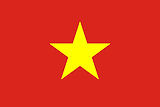
Thailand beschränkt die Niederlassungsmöglichkeit für vietnamesische Flüchtlinge auf 13 Grenz-Provinzen
Abb.: Provinzen, in denen sich 1949 vietnamesische Flüchtlinge niederlassen dürfen
[Bildquelle: CIA. -- Public domain]
1949

Es erscheint das erste Buch des Reform-Muslim Direk Kunsirisawat (ดิเรก กุลสิริสวัสดิ์ / อิบรอฮีม กุเรชี = Ibrahim Qureyshi) (1923 - ):ดิเรก กุลสิริสวัสดิ์ [Direk Kunsirisawat] <1923 - >: สวัสดิภาพสังคม. -- "Social welfare"
1949
Es erscheint:
Lu
Cho-ying: Lun pen-hui-chih li-ch’ang yii chin-hou-chih kung-tso fang- hsiang [On the present position of the [Ch’ao-an] Association and the direction of its future work]. -- In: 旅暹潮安同鄉會成立廿一週年紀念特刊. -- Bangkok : 旅暹潮安同鄉會, 1948. -- Verschiedene Paginierung : Ill. ; 27 cm.
"Some people have criticized the existence of sharply distinguished hsien [Distrikt - 县/Xian] associations as obstructing unification. . . . [Actually] it is just the opposite. The hsien associations serve as starting points for the unification of all Chinese in Thailand. The weakness of the Chinese community today cannot and need not be denied. Evil phenomena such as mutual slandering and attacking make foreigners laugh at us to our self-debasement. ... If we can follow the principle of "cultivate [the self], order [the family], administer [the country] and pacify [the empire]," then the function of the hsien associations cannot be slighted. . . . From the above, there are three functions of the hsien associations:
- to unite fellow natives so that "orphans overseas" will feel settled and regard the association as a second home,
- to unite in order to survive fierce competition, and
- to be the foundation of the greater organization of the Chinese community in order to benefit our country."
[Übersetzung: Skinner, William <1925 - 2008>: Leadership and power in the Chinese community of Thailand. -- Ithaca, N.Y. : Cornell Univ. Pr., 1958. -- 363 S. ; 24 cm. -- (Monographs of the Association for Asian Studies ; 3). -- S. 113f. -- Fair use]
1949
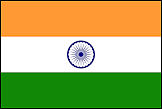
Bangkok: Gründung einer Niederlassung der Indian Overseas Bank (seit 1973: Bharat Overseas Bank).
Abb.: ®Logo
1949

Die Sowjetunion ernennt einen Handelsattaché für Thailand, um den Handel zwischen den beiden Staaten zu fördern. Die Sowjetunion ist besonders an thailändischem Kautschuk interessiert.
1949 - 1952

Der Linksintellektuelle Suphat Sukhonthapirom (สุ
ภัทร สุคนธาภิรมย์) arbeitet als Übersetzer für die Nachrichtenagentur der Sowjetunion, TASS (Телеграфное агентство Советского Союза) und entgeht so der Verfolgung durch die Thai Behörden.
1949

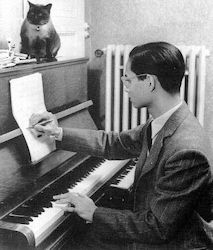
Kompositionen König Bhumibols 1949:
- Blue Day - อาทิตย์อับแสง (1949-02-03 in Davos, Schweiz, geschrieben)
- englischer und Thai Text von Prinz Chakrabandh Pensiri (พระเจ้าวรวงศ์เธอ พระองค์เจ้าจักรพันธ์เพ็ญศิริ, 1909 - 1993)
"According to H.H. Prince Chakrabandh Pensiri's diary, the love songs "Blue Day" and "Dream of Love, Dream of You" spoke of a lovebird longing for his sweetheart. They were written at the time when His Majesty and his fiancée, then-Mom Rajawongse Sirikit Kitiyakara, were temporarily separated, the latter being in Lausanne: "The day is blue when you are so far away, and so, after sundown, I dream that the angels will bring us 'dream lovers' together in the land of rainbows, roses, and dreams."" [Quelle: http://thailand.prd.go.th/ebook/king_music/melodies.html. -- Zugriff am 2013-12-09]]
für Manohra-Ballett (มโนราห์)
Der Song auf Spotify:
URI: spotify:track:6bsgbC5V9x9J9MTlcvMhDB
URL: https://open.spotify.com/track/6bsgbC5V9x9J9MTlcvMhDB
- Dream of Love Dream of You - เทวาพาคู่ฝัน (1949-02-07 in Davos, Schweiz, geschrieben)
- englischer und Thai Text von Prinz Chakrabandh Pensiri (พระเจ้าวรวงศ์เธอ พระองค์เจ้าจักรพันธ์เพ็ญศิริ, 1909 - 1993)
Der Song auf Spotify:
URI: spotify:track:5gRriFChfpjmV8LlXBBoJF
URL: https://open.spotify.com/track/5gRriFChfpjmV8LlXBBoJF
- Sweet Words - คำหวาน (1949-02-13, kurz nach der Rückkehr des Königs aus der Schweiz nach Thailand)
- englischer und Thai Text von Prinz Chakrabandh Pensiri (พระเจ้าวรวงศ์เธอ พระองค์เจ้าจักรพันธ์เพ็ญศิริ, 1909 - 1993)
Der Song auf Spotify:
URI: spotify:track:1WTHhaE8VYlWe7cKkRvunf
URL: https://open.spotify.com/track/1WTHhaE8VYlWe7cKkRvunf
- Maha Chulalongkorn - มหาจุฬาลงกรณ์ (1949-02-18): Alma Mater für die Chulalongkorn University (จุฬาลงกรณ์มหาวิทยาลัย)
Thai-Text: Thanpuying Somroj Swasdikul Na Ayudhya (ท่านผู้หญิงสมโรจน์ สวัสดิกุล ณ อยุธยา, 1913 - 2007) und Mr. Suporn Polcheewin (สุภร ผลชีวิน)
Orchestrierung in klassischer Thai-Art (1954): Mr. Taywaprasit Phattayakosol (เทวาประสิทธิ์ พาทยโกศล)
Der Song auf Spotify:
URI: spotify:track:1lGg3pZJlPWDHqG3j9FhGM
URL: https://open.spotify.com/track/1lGg3pZJlPWDHqG3j9FhGM
- Lovelight in My Heart - แก้วตาขวัญใจ
- englischer und Thai Text von Prinz Chakrabandh Pensiri (พระเจ้าวรวงศ์เธอ พระองค์เจ้าจักรพันธ์เพ็ญศิริ, 1909 - 1993)
Der Song auf Spotify:
URI: spotify:track:46HwKOvwbUF3YegHE6YzjF
URL: https://open.spotify.com/track/46HwKOvwbUF3YegHE6YzjF
1949
Premiere des Films พันท้ายนรสิงห์ (Phanthaay Norasingh Oarsman Norasingh) von Rattana Pestonji (รัตน์ เปสตันยี, 1908 - 1970); Regie: Prinz Bhanubandhu Yukol ( พระเจ้าวรวงศ์เธอ พระองค์เจ้าภาณุพันธุ์ยุคล, 1910 - 1995).
1949
Es erscheint die zweite Auflage des Romans:
หลวงวิจิตรวาทการ [Luang Wichitwathakan] <1898 - 1962>: ดอกฟ้าจำปาสัก [Himmlische Blume von Champassak]. -- Popularisiert die Thai-nationalistische Sicht von Anuvong (ສົມເດັຈພຣະເຈົ້າອານຸວົງສ໌ - เจ้าอนุวงศ์, 1767 - 1829), König von Vientiane (ວຽງຈັນ)
Abb.: Einbandtitel
Abb.: Einbandtitel einer späteren Ausgabe
1949
Es erscheint:
เปล่ง วิเทียมญลักษณ์: ปลัดเปล่งเที่ยวรอบโลก. -- พระนคร : โรงพิมพ์อุทัย, 2492 [= 1949]. -- "Palat Pleng's Weltreise". Das Buch wird ein Bestseller.
Abb.: Einbandtitel
1949
Es erscheint die Kurzgeschichte
อิศรา อมันตกุล [Isra Amantakul] <1921 - 1969>: ศตวรรษแห่งภราดรภาพ [Das Zeitalter der Brüderlichkeit]. -- Eines der ersten Werke sozialkritischer Literatur.
1949

Es erscheint
Landon, Margaret <1903 - 1993>: Never dies the dream : a novel of Bangkok. -- Garden City : Doubleday, 1949. -- 309 S. : 22 cm.
Abb.: Umschlagtitel
1949

Die Schweiz eröffnet die Botschaft in Bangkok.
1949
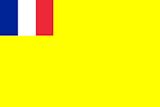
Es erscheint:
Decoux, Jean <1884 - 1963>: A la barre de l'Indochine; histoire de mon gouvernement général, 1940-1945. -- Paris, Plon, 1949. -- 507 S. : Ill. ; 23 cm
Abb.: Umschlagtitel
"In Indochina, the Marshal [Philippe Pétain, 1856 - 1951] enjoyed great prestige, and was the object of boundless veneration. This is a historical fact, which no one can dispute. For nearly all the French in Indochina, the Marshal incarnated the distant fatherland. He was the savior and the preserver of France, and embodied its flag. For the Indochinese, this feeling ran deeper still, and I would have acted criminally had I attempted to stem it. By virtue of his age, his peasant origins, his experience, his victory at Verdun, and also his new slogan "Travail, Famille, Patrie"—which corresponded admirably with the profound and traditionalist aspirations of the masses, and fit unexpectedly well into Confucian philosophy—Petain, one must admit, received from the outset the respect and admiration of Indochinese peoples." [a.a.O. -- Übersetzung: Jennings, Eric Thomas <1970 - >: Vichy in the tropics : Pétain's national revolution in Madagascar, Guadeloupe, and Indochina, 1940-1944. -- Stanford. : Stanford UP, 2001. -- 311 S. : Ill. ; 24 cm. -- ISBN 0-8047-5047-5. -- S. 130]
Abb.: Persönliches Emblem von Marschall Petain
[Bildquelle: Tom Lemmens / Wikimedia. -- Creative Commons Lizenz (Namensnennung)]
1949-01 - 1951-10
Der Senat Senats (พฤฒสภา), in dem die Democrat Party (พรรคประชาธิปัตย์) vorherrscht, unternimmt u.a. Folgendes:
- Zurückweisung von 34 (von 60) Gesetzen an das Repräsentantenhaus (สภาผู้แทนราษฎรไทย)
- wesentliche Veränderungen an 22 (der restlichen 26) Gesetzen
- 35 Anfragen an die Regierung
- bezüglich des Opium-Schmuggels durch die Polizei
- wegen der Anschaffung von Sub-Standard bewaffneten Fahrzeugen durch das Verteidigungsministerium
- wegen der Brutalität beim Niederschlagen von Rebellionen
1949-01

Anglo-Thai Abkommen über die Zusammenarbeit der Streitkräfte bei der Bekämpfung kommunistischer Guerillas in der Grenzregion mit Malaya. Es soll verhindert werden, dass die malaiischen Guerillas Thai-Territorium als Rückzugsgebiet nutzen können.
1949-01
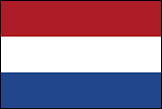
Der indische Ministerpräsident Jawaharlal Nehru (जवाहरलाल नेहरू, 1889 - 1964) ruft die asiatischen Staaten zu einer Konferenz über das Indonesien-Problem auf. Thailand lehnt den Vorschlag zunächst ab und erwägt später die Teilnahme als Beobachter. Indonesien führt seit 1945 einen Unabhängigkeitskrieg gegen die Kolonialherrschaft der Niederlande.
1949-01-01
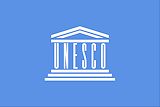
Thailand wird Mitglied der United Nations Educational, Scientific and Cultural Organization (UNESCO).
1949-01-14
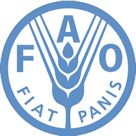
Food and Agriculture Organization of the United Nations (FAO) eröffnet in Bangkok ihr Far Eastern Regional Office.
1949-01-15

Sathiara Bodhinunta (เสถียร โพธินันทะ), Dr. Boonyong Vongvanij (บุญยง ว่องวานิช ) and Supoj Saengsomboon (สุพจน์ แสงสมบูรณ์) gründen 'Yuwabuddhiga' - The Young Buddhists Group (คณะยุวพุทธิกะ, heute: Young Buddhists Association of Thailand (YBAT) - under Royal Patronage - ยุวพุทธิกสมาคมแห่งประเทศไทย ในพระบรมราชูปถัมภ์)
Abb.: ®Logo
1949-01-20
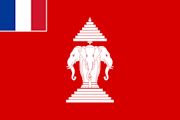
Laos: Gründung der kommunistischen Lasavong-Brigade unter Kaysone Phomvihane (ໄກສອນ ພົມວິຫານ, 1920 -1992). Sie ist die Vorläuferin der kommunistischen Laotischen Volksarmee.
1949-01-21 - 1953-01-20

Dean Acheson (1893 - 1971) ist US Secretary of State (Außenminister).
Abb.: Dean Acheson
[Bildquelle: Departement of State / Wikipedia. -- Public domain]
1949-02
Occupational Restriction Act. Zehn Berufe werden für Thai-Staatsbürger reserviert (und Chinesen davon ausgeschlossen). 1951-08 werden durch Kabinettsbeschluss sechs weitere Berufe hinzugefügt. 1952 per Gesetz nochmals drei weitere Berufe.
1949-02
Die Büros der Zeitung Chung Ming Pao werden vom Staat gestürmt. Die Zeitung hatte seit der letzten Durchsuchung 1948-07 ihre tägliche Auflage von 5.000 auf 10.000 steigern können.
1949-02

George M. Abbott, US Konsul in Saigon:
"1. United States – Post war relations between the United States and Indochina got off to a bad start with President Roosevelt's views on international trusteeship for strategic areas in the hands of powers unable to defend them, followed by the overenthusiastic activities of certain OSS agents in the period just before and after the Japanese surrender. The belief that the policy of the United States is to throw the French out of Indochina still persists in many circles both in Indochina and in France. We are also blamed for permitting the Chinese and English to occupy the northern and southern halves of the country to disarm Japanese troops. Our persistent refusal to supply equipment and arms for French military operations in Indochina is a sore subject with most French army officers. Another source of irritation has been the almost universal tendency of American correspondents visiting Indochina to write articles extremely critical of the French... "In recent weeks the French have actively supported proposals for four power cooperation in Southeast Asia to prevent the spread of communism, and there has been much talk about the strategic importance of Indochina as a bastion against the southward spread of Chinese Communists.
"As far as the Annamites are concerned, they were encouraged to believe that after the defeat of Japan we would assist them in obtaining independence. As it became apparent that our sympathies were tempered by strategic considerations in Europe, the popularity of the United States has diminished. Nevertheless, the prestige of the United States is still high, and even Ho Chi Minh has been careful to prevent any public anti-American propaganda..."No one knows how many communists there are in Indochina, but the number of real party members is certainly small. The highest estimate is 20% of the troops fighting with Ho Chi Minh and this includes sympathizers. However, the number is undoubtedly growing, and at the same time non-communist military units are being steadily infiltrated with secret agents. Units under communist command are generally better armed. Thus the problem for the leader contemplating changing sides is not an easy one.
"Another point on which definite information is lacking is the channel of communications with Moscow and the center of regional control...Certainly satisfactory communications exist since Moscow publications of fairly recent date are frequently seized by the French..."One peculiar thing about Vietnam Communism is that there has been very little anti-American propaganda. It is obvious that this is not due to ignorance of the current party line. It apparently represents a hope on the part of Ho Chi Minh that he may still obtain American support for or at least acceptance of a Viet Minh government under his leadership. Evidence that this hope is diminishing is furnished in a regional party directive dated in November 1948 which stated that active anti-American propaganda should be conducted in party circles and by word of mouth among the people but should not yet appear on the radio, in the press, or in public speeches...
"Opposed to the French forces are about 75,000 Vietnamese troops of various political complexions, largely under communist dominated leadership. There is considerable French-furnished evidence of communist political commissars and indoctrination extending down to company strength levels. It is certain that the disciplined communist element has been the largest factor in maintaining the vigor and cohesiveness of the resistance. In this, they have been greatly helped by French indecision and bad faith, and the terrorism of French troops."In spite of arms captures and occasional defections, there is no sign of large scale weakening of Vietnamese resistance abilities or morale. The large areas under Vietnamese control lack luxuries and medicines, but are wholly self-sufficient in the basic necessities and tolerably well administered, according to what few reports are available. They continue to form a source of supplies and of fresh troops that are only limited in numbers by the arms available.
"Although there are rumors of a Chinese Communist treaty with Ho Chi Minh, and of a Chinese Communist general and his staff in Northern Tonkin, there is little evidence, as yet, that the Chinese are of any considerable help in the resistance. French sources feel that there is little danger of a Chinese Communist 5th column in Cochinchina, or of an invitation on the part of Ho Chi Minh to the troops of the age-old national enemy to enter Indochina in force, in spite of the communist link. All French military sources consulted, however, feel that a large scale Chinese Communist invasion would make most, if not all, of Tonkin, militarily untenable."For many months past, observers feel that the resistance has not put forth its maximum effort, perhaps because the leaders are waiting for the outcome of political negotiations going on between the High Commissariat, the French Government and the Xuan-Bao Dai elements. If these should break down, the resistance will be greatly strengthened by the adhesion of many new neutral or pro-French elements. If the negotiations are successful, the resistance army is sure to be a dominant factor in any form of Vietnamese self-government..."
[Quelle: https://en.wikisource.org/wiki/United_States_%E2%80%93_Vietnam_Relations,_1945%E2%80%931967:_A_Study_Prepared_by_the_Department_of_Defense/I._B._The_Character_and_Power_of_the_Viet_Minh. -- Zugriff am 2016-08-29]
1949-02-08
Die Central Labor Organization (CLO) gibt bekannt, dass sie ebensoviele Chinesen wie Thais als Mitglieder hat, und dass sie Mitglied der kommunistisch orientierten World Federation of Trade Unions (WFTU) geworden ist.
Abb.: ®Logo der WFTU
[Bildquelle: Wikipedia]
"1945 ist der Weltgewerkschaftsbund (Abk. WGB, englisch: World Federation of Trade Unions, französisch: Fédération syndicale mondiale) durch den Zusammenschluss aller Gewerkschaften - unabhängig von ihrer nationalen, ideologischen oder Systemzugehörigkeit - gegründet worden. Besonders die sowjetische Profintern (Профинтерн) sollte mit der Amsterdamer Gewerkschaftsinternationale zusammengeführt werden. Der Kalte Krieg führte 1949 zur Spaltung der internationalen Gewerkschaftsbewegung, einmal in den antikommunistischen Internationalen Bund Freier Gewerkschaften (IBFG, International Confederation of Free Trade Unions ) und den WGB, in dem die Gewerkschaften der sozialistischen Staaten und kommunistischen Parteien nahestehenden Gewerkschaften der nichtsozialistischen Staaten verblieben. Sitz des WGB war bis zur Spaltung im Jahr 1949 Paris. Heute befindet sich der Sitz in Athen."
[Quelle: http://de.wikipedia.org/wiki/Weltgewerkschaftsbund. -- Zugriff am 2012-06-23]
1949-02-10

Memorandum von Edwin F. Stanton, US-Botschafter, an den Secretary of State
"I do not need to emphasize the advisability and timeliness of establishing and implementing an affirmative policy regarding Siam in view of developments in China and the certainty that Communist activities and pressure will be greatly intensified throughout Southeast Asia and this country. It is not argued that this area is equally as important as Europe, but Communism being a global problem, it appears to us here to be both wise statesmanship and good strategy to take steps now before this area is completely dominated by Communism, to contain this threat and give support and encouragement to such countries as Siam which are not yet seriously infected." [Zitiert in: Randolph, R. Sean: The United States and Thailand : alliance dynamics, 1950-1985. -- Berkeley : Institute of East Asian Studies, University of California, 1986. -- 245 S. ; 23 cm. -- (Research papers and policy studies, 12). -- ISBN 0-912966-92-0. -- S. 11]
1949-02-11
Im Nordosten (Isan) breitet sich die Pest aus. In der Provinz Loei (เลย) gibt es 11 Tote. Auch in der Provinz Nakhon Sawan (นครสวรรค์) gibt es drei Fälle von Pest. Man vergiftet Ratten, die Überträger der Pest. Bambusstäbe an Häusern werden entfernt, da Ratten auf diesen auf die Hausdächer klettern. 30.000 Bauern sehen Aufklärungsfilme über Pest. Für viele ist es der erste Film ihres Lebens. Diese Maßnahmen verhindern, dass sich die Pest in die Provinz Sukhothai (สุโขทัย) ausbreitet.
Abb.: Lage der Provinzen Loei (เลย), Nakhon Sawan (นครสวรรค์), Sukhothai (สุโขทัย)
[Bildquelle: CIA. -- Public domain]
1949-02-18
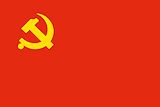
Ministerpräsident Pibul nimmt Gerüchte über eine Allianz zwischen dem chinesischen Kommunistenführer Mao Zedong (毛泽东, 1893 - 1976) und dem vietnamesischen Kommunistenführer Ho Chi Minh (Hồ Chí Minh, 1890 - 1969) zum Vorwand, den Notstand auszurufen.
1949-02-26

"February 26 Democratic Movement / Palace Revolution (กบฏวังหลวง)": Missglückter Putschversuch von ca. 50 Studenten und Lehrenden der Thammasat University (มหาวิทยาลัยธรรมศาสตร์) unter Leitung von Pridi Banomyong (ปรีดี พนมยงค์, 1900 - 1983). Die Putschisten benutzten Waffen, die die Alliierten im Weltkrieg den Seri Thai (ขบวนการเสรีไทย) gegeben hatten. Beim Putschversuch werden 4 Zivilisten getötet und 14 verwundet. Auf Seiten von Militär und Polizei werden 7 getötet und 23 verwundet.
"Thailand's 1949 Palace Rebellion was a failed coup attempt. The aims of its plotters were to overthrow the government of Field Marshal Plaek Phibunsongkhram (แปลก พิบูลสงคราม, 1897 - 1964) and to restore his main civilian rival Pridi Phanomyong (ปรีดี พนมยงค์, 1900 - 1983) to the Thai political scene. Pridi had disavowed the use of violence during the immediate aftermath of the 1947 coup (รัฐประหาร 8 พฤศจิกายน พ.ศ. 2490), but the frustrations of exile eventually overcame him. Although in China, he still maintained contacts with his supporters in Thailand and, with their help, laid plans for a counter-coup. In the first week of February 1949 he secretly returned to Thailand. Phibun however soon learned of Pridi's intentions, and quickly a radio announcement in which he called Pridi his "friend" was made. He went on to offer Pridi a position in the government, but Pridi decided to go ahead with his plans and the field marshal's overtures were rebuffed.
A state of emergency was declared by the government in anticipation of the counter-coup, which began on February 26. On that day an army officer loyal to Pridi and a group of supporters seized a radio station, and Free Thai (เสรีไทย) elements and Thammasat University (มหาวิทยาลัยธรรมศาสตร์) teachers and students occupied the Grand Palace (พระบรมมหาราชวัง). The group at the radio station announced over the air the formation of a new government headed by Pridi's friend Direk Jayanama (ดิเรก ชัยนาม, 1905 - 1965). Major-General Sarit Thanarat (สฤษดิ์ ธนะรัชต์, 1908 - 1963) then moved in troops and managed to easily oust Pridi from the palace grounds. In the meanwhile the navy and marines took up defensive positions around Bangkok to protect its allies.
The rebels managed to escape in naval vessels across the Chao Phraya River (แม่น้ำเจ้าพระยา), and navy units engaged the army in fierce street fighting. A ceasefire was declared that afternoon, although it would take the navy and the army a full week to negotiate a resolution to the crisis."
[Quelle: http://en.wikipedia.org/wiki/Palace_Rebellion. -- Zugriff am 2015-02-03]
1949-02-27
Major Phone Inthorathat (พันตรี โผน อินทรทัต), Seri Thai (เสรีไทย), Naeo Ratthathammanoon Partei (พรรคแนวรัฐธรรมนูญ, Verfassungsfront) wird verhaftet und erschossen.
Abb.: Phone Inthorathat (พันตรี โผน อินทรทัต)
[Bildquelle: th.Wikipedia. -- Fair use]
1949-02-28
Polizisten erschießen Police Colonel Bonjongsak Chippensuk (บรรจงศักดิ์ ชีพเป็นสุข), Seri Thai (เสรีไทย), persönlicher Feind von Police General Phao Sriyanond (เผ่า ศรียานนท์, 1910 - 1960)
1949-03
Erstmals wird in Bangkok Coca-Cola (โคคา-โคล่า) verkauft.
Abb.: Inserat
Abb.: Späteres Thai-Logo® für Coca-Cola
[Bildquelle: Ian Horner. -- http://www.flickr.com/photos/ihorner/340522082/. -- Zugriff am 2011-10-09. -- Creative Commons Lizenz (Namensnennung, keine kommerzielle Nutzung, share alike)]
1949-03-04
"Kilo 11 incident" (เหตุการณ์ กิโล 11 / คดีสังหาร 4 อดีตรัฐมนตรี พ.ศ. 2492): Rebellen greifen bei Kilometer 11 einen Gefangenentransport der Polizei an. Die Polizei hatte vier Politiker aus Nordostthailand festgenommen, denen kommunistische Aktivitäten, Forderung der Autonomie für Nordostthailand (Isaan) sowie Teilnahme am Putschversuch Pridis vorgeworfen wird:
Thong-In (ทองอินทร์ ภูริพัฒน์, 1906 - 1949), ehemals Industrieminister
Chamlong Daoruang (จำลอง ดาวเรือง, 1910 - 1949), früherer stellvertretender Wirtschaftsminister
Thawin Udon (ถวิล อุดล, 1909 - 1949)
Thongpleo Chonlaphoom (ทองเปลว ชลภูมิ, 1912 - 1949)
Die Gefangenen werden getötet, nach Polizeiangaben durch feindliche Geschoße, nach Angaben der Rebellen wurden sie durch die Polizei hingerichtet.
Abb.: Die vier Ermordeten
[Fair use]
1949-03-17
Das Erziehungsministerium ruft die Studierenden auf, Handel und Gewerbe zu lernen statt auf den öffentlichen Dienst hinzuarbeiten.
1949-03-17
Ministerpräsiden Plaek Phibunsongkhram (แปลก พิบูลสงคราม, 1897 - 1964) sagt der Agentur Reuters, dass er glaubt, dass es in Thailand keine signifikante Partei der extremen Linken gäbe. Die Regierung habe nicht vor, die Kommunistische Partei als solche zu verbieten, da die Pressezensur und die Ausschaffung missliebiger Chinesen ausreichende Maßnahmen seien.
1949-03-17

Aufständische Karen (ကရင်လူမျိုး) haben fast ganz Burma (mit Ausnahme Rangoons) unter ihrer Kontrolle.
Abb.: Wohngebiete der Karen (ကရင်လူမျိုး)
[Bildquelle: Peter Ole Kvint / Wikipedia. -- Public domain]
1949-03-23

รัฐธรรมนูญแห่งราชอาณาจักรไทย พุทธศักราช 2492 - The Constitution of the Kingdom of Thailand 1949 (5. Verfassung)
Art: endgültig
In Kraft: 1949-03-23 - 1951-11-29
Dauer: 2 Jahre 8 Monate 6 Tage
aufgehoben: Putsch
1949-03-29
Government Savings Bank (GSB, ธนาคารออมสิน) kündet an, dass sie in allen 412 Amphoe (อำเภอ) Zweigstellen eröffnen will. Zur Zeit hat sie nur in 60 Amphoe Zweigstellen.
Abb.: Logo®
[Bildquelle: Wikipedia. -- Public domain]
1949-03-31
Dr. Thawi Thawetikul, Seri Thai (เสรีไทย), Naeo Ratthathammanoon Partei (พรรคแนวรัฐธรรมนูญ, Verfassungsfront), ergibt sich, wird aber von Polizei erschossen.
1949-04 - 1952-10
Es erscheint die linksliberale (parteiunabhängige) Monatszeitschrift
Aksonsarn (อักษรสาส์น). Anfangs je 150 Seiten dick.
Die Zeitschrift ist Forum für ein breites Meinungsspektrum von anti-kommunistisch, über Konservativ, Liberal, demokratisch, buddhistisch, fabianistisch, marxistisch bis kommunistisch.
In einem Interview 1985 erklärt der Herausgeber Supha Sirimanond [สุภา ศิริมานนท์, 1914 - 1986]:
"I did not publish this magazine for the leftists. The progressive people could find their own reading. I wanted to wash [ฝอก] [fok] the thoughts of the older generation [คนรุ่นเก่า] [khonrunkao] therefore I had a lot of backward, idealistic stuff in the magazine, hoping that having read it, they might perhaps also glance this way and read... [the progressive writings] little by little." [Übersetzt in: Kasian Tejapira [เกษียร เตชะพีระ] <1957 - >: Commodifying Marxism : the formation of modern Thai radical culture, 1927-1958. -- Kyoto : Kyoto Univ. Pr., 2001. -- 390 S. : Ill. ; 23 cm. -- (Kyoto area studies on Asia ; 3). -- ISBN 1876843985. -- Revision of the author's thesis (doctoral) -- Cornell University, 1992. -- S. 165]
Anteilseigner der Zeitschrift:
Name Background Investment Supha Sirimanond
[สุภา ศิริมานนท์, 1914 - 1986]Pro-Pridi veteran journalist and Marxist socialist 5,000 baht Chinda Sirimanond
[จินดา ศิริมานนท์, 1917 - 2013]Supha’s wife and a trained nurse 10,000 baht
(the sole partner with unlimited liability)Luang Suphathep
[หลวง สุภาเทพ]
(Toe Sunthararohit)
[โต สุนทรโรหิต]Supha’s father-in-law, wealthy retired civil servant 1,000 baht Chanid Saipradit
[ชนิด สายประดิษฐ์, 1913 - 2010]Kulap’s [Saipradit - กุหลาบ สายประดิษฐ์, 1905 - 1974] wife; a freelance writer and translator 1,000 baht Uthai Sakhornwasi Druggist and friend of Supha; family owned a Bangkok pharmacy 300 baht Thongtoem Samerasut
[ทองเติม เสมรสุต, 1917 - 1991]caricaturist and columnist; old colleague of Supha at Nikorn Wanathit [นิกรวันอาทิตย์] during the war 200 baht Saengarun Ratkasikorn
[แสงอรุณ รัตกสิกร, 1922 - 1979]Painter and lecturer in the arts at Chulalongkorn University [จุฬาลงกรณ์มหาวิทยาลัย]; designed and painted Aksornsarns cover 100 baht Sommai Huntrakool
[สมหมาย ฮุนตระกูล, 1918 - 1993]Japanese-educated lookjin [ลูกจีน] official at the Bank of Thailand [ธนาคารแห่งประเทศไทย] 100 baht Jaroen Chaichana
[เจริญ ไชยชนะ]Popular historian 100 baht Thuanthai Bamrasarinphai
[ทวนทัย]Close friend of Supha 100 baht [Quelle: Kasian Tejapira [เกษียร เตชะพีระ] <1957 - >: Commodifying Marxism : the formation of modern Thai radical culture, 1927-1958. -- Kyoto : Kyoto Univ. Pr., 2001. -- 390 S. : Ill. ; 23 cm. -- (Kyoto area studies on Asia ; 3). -- ISBN 1876843985. -- Revision of the author's thesis (doctoral) -- Cornell University, 1992. -- S. 161]
Mitarbeiter:
Name Background Editorial Responsibility The Left Supha Sirimanond
[สุภา ศิริมานนท์, 1914 - 1986]Pridi loyalist and one-time personal aide; well-known newspaper editor and reporter Chief editor; international affairs, entertainment and fiction, and translation editor Kulap Saipradit
[กุหลาบ สายประดิษฐ์, 1905 - 1974]Pridi political ally; renowned and respected veteran journalist and novelist Political science editor Atsani Phonlajan
[อัศนี พลจันทร, 1918 - 1987]See Table 8-1 ["Ethnic Thai of old aristocratic family in the central province of Ratchaburi [: ราชบุรี]; graduate in law of Thammasat University [มหาวิทยาลัยธรรมศาสตร์] (1940); audacious state prosecutor better known as an extremely knowledgeable and wildly iconoclastic poet, fiction writer, literary critic, and political and legal essayist of genius; allegedly (perhaps exaggeratedly) fluent or literate in Latin, English, French, Chinese, Hindi, Pali, Sanskrit, Urdu, Malay, Javanese, etc.; member of the TCP [Communist Party of Thailand] from 1950"] Literature editor Samak Burawas
[สมัคร บุราวาศ, 1916 -]Brilliant British-educated philosopher and scientist; member of the Royal Institute [ราชบัณฑิตยสถาน] from 1942 Philosophy and sociology editor Sanan Waraphreug
aka. "ส.ว.พ."Member of the CCP-TB [Chinese Communist Party - Thai Branch] and of the pro-PRC [People Republic of China] Maitrisarn Biweekly [ไมตรีสาส์น]editorial staff Staff writer on international affairs and translator from Chinese Thaweep Voradilok
[ทวีป วรดิลก, 1928 - 2005]Poet, lyricist, Thammasat [มหาวิทยาลัยธรรมศาสตร์] student activist, and editor of the Thammasat Student Committee’s newspaper, Thammajak [ธรรมจักร] in 1949/50 Literature and poetry editor, 1950-52 The "Right" Direk Jayanama
[ดิเรก ชัยนาม, 1905 - 1967]Former foreign minister; ambassador to Japan during the war and to Great Britain afterwards; liberal follower of Pridi International affairs editor Sommai Huntrakool
[สมหมาย ฮุนตระกูล, 1918 - 1993]Master of economics from Japan, where he met Supha in 1938; head of the Research Division of the National Bank [ธนาคารแห่งประเทศไทย] International economy editor Jaroen Chaichana
[เจริญ ไชยชนะ]Popular historian Translation and feature editor; international economy editor Colonel Sanong Thamangraksat
[พันเอก สนอง ถมังรักษ์สัตว์]Graduate in military economics (Italy) and in political science (University of Lausanne, Switzerland) Assistant editor; staff writer and translator in international affairs Pleuang na Nakhorn
[เปลื้อง ณ นคร, 1909 - 1998]Leading literary historian and critic; lecturer in literary composition and journalism at Chulalongkorn University [จุฬาลงกรณ์มหาวิทยาลัย] Literary composition editor [Quelle: Kasian Tejapira [เกษียร เตชะพีระ] <1957 - >: Commodifying Marxism : the formation of modern Thai radical culture, 1927-1958. -- Kyoto : Kyoto Univ. Pr., 2001. -- 390 S. : Ill. ; 23 cm. -- (Kyoto area studies on Asia ; 3). -- ISBN 1876843985. -- Revision of the author's thesis (doctoral) -- Cornell University, 1992. -- S. 166]
Die "Rechten" hören 1950 mit ihrer Mitarbeit auf,
1949-04/07
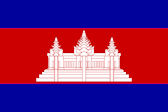
Laut französischen Regierungsquellen besteht die Militärtruppe der kambodschanischen Befreiungsbewegung Khmer Issarak (ខ្មែរឥស្សរៈ) in Battambang aus:
850 Khmer Issarak (ខ្មែរឥស្សរៈ)
460 Viet Minh (Việt Minh)
3 Europäern
6 Japanern
210 Thai
200 Sino-Kamboschanern
640 Mitgliedern gemischter Khmer Issarak / Viet Minh Einheiten
Hunderte nicht näher spezifizierten Mitgliedern
Abb.: Operationsgebiet dieser Truppen
[Bildquelel: CIA. -- Public domain]
1949-04-01
Pibul ordnet an, dass Straßenhändler nur noch auf den öffentlichen Marktplätzen ihre Waren anbieten dürfen. In Bangkok sind 11.154 Straßenhändler registriert.
Abb.: Straßenhändlerin, Bangkok, 2008
[Bildquelle: Shubert Ciencia. -- http://www.flickr.com/photos/bigberto/2890898755/. -- Zugriff am 2011-10-09. -- Creative Commons Lizenz (Namensnennung)]
1949-04-12
United Nations Children's Fund (UNICEF) eröffnet in Bangkok ein Office zur Bekämpfung der Tuberkulose.
1949-04-14

Erstflug des C/STOL Transportflugzeugs Helio Courier. Auslieferung ab 1954. Wird auch bei der Royal Thai Airforce zum Einsatz kommen.
Abb.: Helio Courier der Royal Thai Airforce, Museum, 2011
[Bildquelle: Reedhawk / Wikimedia. -- Public domain]
1949-04-20

Siam und Frankreich beschließen ihre Delegationen zu Botschaften aufzuwerten.
1949-05-30

Gründung der League for National Salvation of Vietnamese Residents in Cambodia. Aus ihren Statuten:
"Dated 30 April 1949, the statutes of the League for National Salvation of the Vietnamese Residents in Cambodia point out that Khmer and Vietnamese revolutionary organizations ‘must live side by side to help one another, to exchange initiatives and lessons drawn from experience, to help the two peoples to understand one another, to realise in deeds Khmer- Vietnamese friendship, to conclude on the basis of equality an alliance between the two peoples in the struggle against the reactionary French colonialists, invaders of Cambodia and of Vietnam.’
The same document goes on to show how revolutionary power should be allocated in Kampuchea. It claims that Khmer sympathizers had agreed to the following:
- 'In the localities inhabited entirely by Vietnamese, the latter may take part in the Government of their localities.
- In the localities populated by Cambodians and Vietnamese where the Cambodian element forms the majority of the population the Vietnamese may occupy auxiliary posts in the Government of their localities to aid the Cambodian authorities and conciliate the interests of the Vietnamese with those of the Cambodians.
- The internal administration is entirely the province of the Cambodian government and is assured by the Cambodians.'"
[Quelle: Kiernan, Ben <1953 - >: How Pol Pot came to power : Colonialism, nationalism, and communism in Cambodia, 1930 - 1975. -- 2. ed. -- New Haven : Yale UP, 2004. -- 430 S. : Ill. ;21 cm. -- ISBN 978-0-300-10262-8. -- S. 65. -- Fair use]
1949-05-01
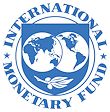
Thailand wird Mitglied des International Monetary Fund (IMF).
1949-05-07

Prinzregent Rangsit von Chainat vollzieht erstmals seit den 1920er Jahren wieder die königliche Pflügezeremonie (พระราชพิธีพืชมงคลจรดพระนังคัลแรกนาขวัญ).
Abb.: Das Volk sammelt den Reis nach der königlichen Pflügezeremonie, Bangkok, 2009-05-11
[Bildquelle: Xiengyod / Wikipedia. -- GNU FDLicense]
"The Royal Plowing Ceremony is an ancient royal rite held in Cambodia and Thailand to mark the traditional beginning of the rice-growing season. In the Khmer language, it is called "Preah Reach Pithi Chrot Preah Neangkol" (Khmer:ព្រះរាជពិធីបុណ្យច្រត់ព្រះនង្គ័ល), and in Thai: การพืชมงคล (Kan Phuetchamongkhon); in full พระราชพิธีพืชมงคลจรดพระนังคัลแรกนาขวัญ[2] (Phra Ratchaphithi Phuetchamonkhon Charot Phra Nangkhan Raek Na Khwan; also observed as Farmer's Day.) The royal ploughing ceremony was also practiced in pre-colonial Burma, before the abolishment of the monarchy, where it was called လယ်ထွန်မင်္ဂလာ (IPA: [lɛ̀tʰʊ́ɴ mɪ̀ɴɡəlà]), before the beginning of the Buddhist lent in the Burmese month of Waso (June to July).[3]
In 2009, the ceremony was held on May 11 in Thailand and on May 12 in Cambodia. The date is usually in May, but varies as it is determined by Hora (astrology) (Khmer:ហោរាសាស្រ្ត (hourasastr), Thai: โหราศาสตร์ (horasat)).
In the ceremony, two sacred oxen are hitched to a wooden plough and they plough a furrow in some ceremonial ground, while rice seed is sown by court Brahmins. After the ploughing, the oxen are offered plates of food, including rice, corn, green beans, sesame, fresh-cut grass, water and rice whisky.
Depending on what the oxen eat, court soothsayers make a prediction on whether the coming growing season will be bountiful or not. The ceremony is rooted in Brahman belief, and is held to ensure a good harvest.
In Thailand, the rite dates back to the Sukhothai Kingdom (1238–1438). By the time of King Prajadhipok in the 1920s, the practice had been discontinued. It was revived in 1960 by King Bhumibol Adulyadej.[4][5]
In both Cambodia and Thailand, the ceremony is typically presided over by the monarch, or an appointee. Sometimes the monarch himself has taken part in the ceremony and actually guided the plough behind the oxen.
In recent years in Thailand, Crown Prince Maha Vajiralongkorn has presided over the ceremony, which is held at Sanam Luang in Bangkok. Rice grown on the Chitralada Palace grounds, home of King Bhumibol Adulyadej is sown in the ceremony, and afterward, onlookers swarm the field to gather the seed, which is believed to be auspicious. Farmers will often mix the grains with their own rice stock, or the grains might be kept as a good luck charm.
In Cambodia, both King Norodom Sihamoni and Prime Minister Hun Sen have overseen the rite.
References
- "The Royal Ploughing Ceremony 2011". Tourism Cambodia. Ministry of Tourism, Cambodia. Retrieved 18 July 2011.
- Royal Institute Dictionary 1995
- Nisbet, John (1901). Burma under British rule--and before. University of Michigan Press. pp. 333.
- Ancient rituals for a bountiful harvest, TAT News, retrieved 2007-5-10.
- Abundant crops expected in Thailand in 2007, Thai News Agency, MCOT, 2007-5-10."
[Quelle: http://en.wikipedia.org/wiki/Royal_Ploughing_Ceremony. -- Zugriff am 2011-10-09]
1949-05-08 - 1949-05-15


König Bhumibol besucht das Festival International 1949 de Jazz in Paris (Frankreich). Er ist besonders beeindruckt vom Britischen Saxophonisten, Klarinettisten und Komponisten John Dankworth (1927 - 2010).
Künstlerlink auf Spotify:
URI: spotify:artist:5IZvXM7XkysHxK1PAlsa8Y
URL: https://open.spotify.com/artist/5IZvXM7XkysHxK1PAlsa8Y
Abb.: John Dankworth, 2002
[Bildquelle: Mykp / Wikimedia. -- Public domain]
1949-05-08

Thailand wird Mitglied der International Bank for Reconstruction and Development (IBRD).
1949-05-11
Nach monatelanger Debatte zwischen Nationalisten unter der Führung des Putschisten Col. Karn Chamnongbhumived und liberalen Intellektuellen unter der Führung von Prof. Inthorn Singhanetr und MR Seni Pramoj wird der Name des Staats wieder von Siam in Thailand umgewandelt.
Königreich Thailand - ราชอาณาจักรไทย
1949-05-12
Prinz Boworadet (พระเจ้าบรมวงศ์เ้ธอ พระองค์เจ้าบวรเดช, 1877 - 1953), der Anführer des gescheiterten royalistischen Putsches von 1933-03-11 kehrt mit seiner Familie aus dem Exil in Französisch-Indochina zurück. Er will eine Textilfirma gründen.
Abb.: Prinz Boworadet (พระเจ้าบรมวงศ์เ้ธอ พระองค์เจ้าบวรเดช, 1877 - 1953)
[Bildquelle: Wikipedia. -- Public domain]
1949-05-13 - 1951

Léon Marchal (1900 - 1956) ist französischer Botschafter in Thailand,
1949-05-24


Königin Rambhai Barni (รำไพพรรณี, 1904 - 1984) bringt aus England die Asche des dort verstorbenen, abgedankten Königs Rama VII. nach Bangkok.
Abb.: Die Asche von Rama VII. wird vom Schiff gebracht
[Bildquelle: Wikipedia. -- Public domain]
1949-06

Bewertung der Regierung Thailand durch das National Security Council der USA:
"The current conflict between colonialism and native independence is the most important political factor in southeast Asia. This conflict results not only from the decay of European imperial power in the area but also from a widening political consciousness and the rise of militant nationalism among the subject peoples. With the exception of Thailand and the Philippines, the southeast Asia countries do not possess leaders practiced in the exercise of responsible power." [The Pentagon Papers. -- http://en.wikisource.org/wiki/United_States_%E2%80%93_Vietnam_Relations,_1945%E2%80%931967:_A_Study_Prepared_by_the_Department_of_Defense/I._A._U.S._Policy,_1940%E2%80%9350. -- Zugriff am 2013-12-03"
1949-06-05

Wahlen.
Abb.: Sitzverteilung im Parlament nach den Wahlen 1949-06-05
[Datenquelle: Thak (1978), S. 46]
Abb.: Minister und Staatssekretäre nach den Wahlen 1949-06-05
[Datenquelle: Thak (1978), S. 46]
1949-06-07
Schulleiterin Orapin Chaiyakan (อรพินท์ ไชยกาล, 1904 - 1996), Gattin des Innenministers, wird als erste Frau ins Parlament gewählt. Ihr folgen am 22. Juni La-iad Pibun Songkram (ละเอียด พิบูลสงคราม), Gattin des Ministerpräsidenten Pibun, und Lekha Aphaiwong (เลขา อภัยวงศ์, gest. 1983), Gattin des früheren Ministerpräsidenten Khuang.
Abb.: Orapin Chaiyakan (อรพินท์ ไชยกาล)
[Bildquelle: http://veryhistory.pad-soa-th.com/history/5424. -- Zugriff am 2012-10-08. -- Fair use]
1949-06-14 - 1955-10-26
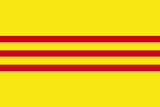
Gründung des État du Viêt Nam (Quốc gia Việt Nam) als État associé de l'Union française. Bảo Đại (1913 – 1997) ist Staatschef (Quốc Trưởng). Hauptstadt ist Saigon. Dieser Staat wird von den nordvietnamesischen Kommunisten nicht anerkannt.
1949-06-14

Aufnahme diplomatischer Beziehungen mit den Philippinen. Unterzeichnung eines Freundschaftvertrags beider Länder.
1949-06-14

Burma: Proklamation des separatistischen Karen-Staats Kawthoolei. Hauptstadt ist Papun (ဖာပွန်မြို့)
Abb.: Lage von Kawthoolei und Papun (ဖာပွန်မြို့)
[Bildquelle: OpenStreetMap. -- Creative Commons Lizenz (Namensnennung, share alike)]
"Kawthoolei is the Karen name for the state that the Karen people of Myanmar have been trying to establish since the late 1940s. Kawthoolei roughly approximates to present-day Kayin State (ကရင်ပြည်နယ်), although parts of the Burmese Ayeyarwady River (ဧရာဝတီမြစ်) delta with Karen populations have sometimes also been claimed. Kawthoolei, as a name, was penned during the time of former Karen leader Ba U Gyi (စောဘဦးကြီ, 1905 - 1950), who was assassinated around the time of Burma's independence from Britain. Kawthoolei has also been spelled ‘Kaw-thu-lay’ or ‘Kawthoolie’ with the last syllable replacing the ‘lay’ with ‘lea.’ The name ‘Kaw-thu-lay’ was used by the Government of the Union of Burma in drawing up its constitution which made provisions within a Karen State. Prior to the adoption of Kawthoolei there were a number of other names to denote what the Karen people would call a Karen state. In the early 1900s, the historical term used for a Karen land was Kaw Lah or ‘green land’ – and it is unclear as to why the new name was adopted, although it probably developed due to Karen political aspirations after the Second World War. Kawthoolei is not the only name used to refer to a Karen country: the Pwo Karen use the phrase ‘Kan Su Line’, literally ‘land cool cave’.[1]
The precise meaning of Kawthoolei is disputed even by the Karen themselves. Kawthoolei, literally means a land without evil in Sqaw Karen.[2] However even this translation is at odds with the linguistic realities. It serves to reinforce a particular conception of Karen society and is attributed to the influence of Christian beliefs. The translation as ‘a land where the Thoo Lei flower grow’ can similarly be interpreted. As one elder pointed out, the Thoo Lei flower can be found throughout the country, and even in Thailand, where Karen People settled around northern Thai City ChingMai (Karen people call it Keimel, Burmese Kings called it Zinmel), and as such the term could be interpreted as the Karen making a claim for Burma in its entirety, and perhaps adding even more territory. According to Martin Smith in "Burma: Insurgency and the Politics of Ethnicity", Kawthoolei has a double meaning, and can also be rendered as the Land Burnt Black; hence the land that must be fought for."
[Quelle: https://en.wikipedia.org/wiki/Kawthoolei. -- Zugriff am 2016-04-30]
1949-06-20

Das neue Privy Council (สภาองคมนตรีไทย) bestätigt Prinz Rangsit von Chainat (สมเด็จพระเจ้าบรมวงศ์เธอ พระองค์เจ้ารังสิตประยูรศักดิ์ กรมพระยาชัยนาทนเรนทร, 1885 - 1951-03-07) einstimmig zum Prinzregenten.
1949-06-21
Die Borneo Company beginnt Ausflugstouren für Touristen zu organisieren. Die ersten Bus-Routen führen nach Ayutthaya (อยุธยา) und zum Wasserfall am Khao Ito (น้ำตกเขาอีโต). Dies ist vermutlich der Beginn des Bustourismus in Thailand.
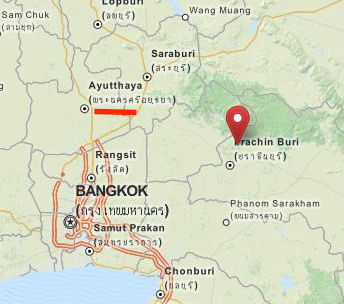
Abb.: Lage
von Ayutthaya (อยุธยา)
und Khao Ito (น้ำตกเขาอีโต)
[Bildquelle: OpenStreetMap. --
Creative Commons Lizenz (Namensnennung, share alike)]
1949-06-25 - 1951-11-29
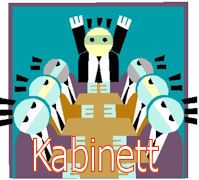
22. Kabinett: Pibul (พิบูลสงคราม) IV
1949-06-25
In Bangkok werden 10.000 neue Wasseruhren in Häusern installiert, die bisher eine Wasserpauschale bezahlt haben. Die Wasserwerke erhoffen sich dadurch Mehreinnahmen von 1Mio. Baht pro Jahr.
1949-06-29
Der Film "Suparb Burut Sua Thai" (สุภาพบุรุษเสือไทย, Thai Gentlemen Fighters) wird ein Kassenschlager. Filmemacher: Thae Prakaswutthisan (แท้ ประกาศวุฒิสาร, 1918 - ) und Sukavannadit Diskul (หม่อมเจ้าศุกรวรรณดิศ ดิศกุล, 1909 - 1976)
Abb.: Filmplakat für "Suparb Burut Sua Thai" (สุภาพบุรุษเสือไทย, Thai Gentlemen Fighters)
[Bildquelle: Wikipedia. -- Public domain]
1949-07-11
Auf den Philippinen vereinbart der Führer der Nationalchinesen, Chiang Kai-shek (蒋介石, 1887 - 1975), und der philippinische Präsident Elpidio Quirino (1890 - 1956), einen antikommunistischen Pazifikpakt (Pacific Pact) zu bilden, zu dem auch Südkorea gehören soll. Man will Thailand, Indonesien, Australien und Neuseeland zum Beitritt auffordern.
Abb.: Für den Pazifikpakt vorgesehene Länder
[Bildquelle: Ionut Cojocaru / Wikipedia. -- Creative Commons Lizenz (Namensnennung)]
1949-07-18
Gesetz zur Beschränkung von Grundbesitz durch Ausländer in Thailand.
Gesetz zum Verbot von Lautsprecheransagen und Radiosendungen in Fremdsprachen.
1949-07-19


Verlobung des 21jährigen König Bhumibol (geb 1927) mit der knapp 17jährigen Mom Rajawongse Sirikit Kitiyakara (หม่อมราชวงศ์สิริกิติ์ กิติยากร, geb. 1932-08-12) in Lausanne (Schweiz).
Abb.: Lage von Lausanne
[Bildquelle: OpenStreetMap. -- Creative Commons Lizenz (Namensnennung, share alike)]
1949-07-19
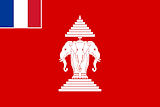
Frankreich gewährt Laos beschränkte Autonomie innerhalb der Union Française. Prinz Souvanna Phouma (1901 - 1984) kehrt aus dem Exil in Bangkok nach Laos zurück.
1949-07-24
Die New York Times zitiert Ministerpräsident Pibul: er glaube, dass der Aufstand in Indochina in erster Line eine nationale Unabhängigkeitsbewegung sei, und dass was in anderen Staaten Südostasiens geschehe, Thailand wenig tangiere.
1949-07-27

Großbritannien: Erstflug der de Haviland DH 106 Comet 1. Es ist das erste serienmäßig hergestellte düsengetriebene Verkehrsflugzeug.
Abb.: Prototyp Comet 1, 1949-10-04
[Bildquelle: British official photographer / Wikipedia. -- Public domain]
1949-08-06

Pridi Banomyong flieht über Singapur nach Hong Kong (香港). Dort erhält er von Rot-China die Einladung, nach Beijing (北京) ins Exil zu kommen. Er folgt dieser Einladung.
Abb.: Singapur - Hong Kong (香港) - Beijing (北京)
[Bildquelle: OpenStreetMap. -- Creative Commons Lizenz (Namensnennung, share alike)]
1949-08-27 - 1949-08-28


Der König besucht das Autorennen Grand Prix Automobile, Lausanne. Am Start ist auch Prinz Bira (พระองค์พีระ, Prinz Birabongse Bhanutej Bhanubhandhu - ร้อยเอก พระวรวงศ์เธอ พระองค์เจ้าพีรพงศ์ภาณุเดช, 1914 - 1985) mit einem Maserati 4 CLT.
Abb.: Maserati 4 CLT (nicht der von Prinz Bira!)
[Bildquelle: John Chapman / Wikimedia. -- GNU FDLicense]
1949-08-29
Weil sie mit einem veränderten Arbeitsvertrag mit der Regierung unzufrieden sind, streiken über 10.000 Zuckerrohrarbeiter in den Provinzen Lampang (ลำปาง), Uttaradit (อุตรดิตถ์) und Udon Thani (อุดรธานี).
Abb.: Lage der Provinzen Lampang (ลำปาง), Uttaradit (อุตรดิตถ์) und Udon Thani (อุดรธานี)
[Bildquelle: CIA. -- Public domain]
1949-08-29

Die Sowjetunion zündet ihre erste Atombombe in einem Test.
Abb.: Erster Atombombentest der Sowjetunion, 1949-08-29
[Bildquelle: Wikimedia. -- Public domain]
1949-09-19

Abwertung des britischen Pfund um 30 $. Während bisher £1 = US-$4,03 ist jetzt £1 = US-$2,80.
1949-09-20
Die Polizei geht gegen Astrologen vor, da die Regierung vermutet, dass einige Astrologen ihre Aussagen dazu benutzen, um das Volk gegen die Regierung aufzubringen.
Abb.: Astrologische Thai-Handschrift
[Bildquelle: Wellcome Images. -- Creative Commons Lizenz (Namensnennung, keine kommerzielle Nutzung)]
Abb.: Astrologe, Bangkok, 2007
[Bildquelle: supercake. -- http://www.flickr.com/photos/supercake/515825664/. -- Zugriff am 2011-10-10. -- Creative Commons Lizenz (Namensnennung, keine kommerzielle Nutzung)]
1949-09-25
Udom Udakan (อุดม อุดาการ aka อ. อุดากร, 1924-1951) in einem Brief an Supha Sirimanond (สุภา ศิริมานนท์, 1914 - 1986):
Abb.: Einbandtitel eines Buchs von Udom Udakan (อุดม อุดาการ aka อ. อุดากร)
"What is Marxism? What is Leninism? These are questions whose answers I would like to know for a very long time. And my agonizing curiosity grows even stronger with the turning of the tide of the Chinese civil war in Mao Tse-tung's [毛澤東, 1893 - 1976] favor...The wave of the October Revolution [Вели́кая Октя́брьская социалисти́ческая револю́ция], which had reconstructively transformed Russia into a socialist country, has now hurled its enormous swell into Asia. And I wonder when it will reach Thailand. But there is one thing I am sure of: definitely it must arrive. Hence a desire which I have always cherished in my heart, namely, how I can come to own a book that at least sheds some light on or solves these questions of mine with sufficient clarity [words in italics appeared in English in the original]" [Übersetzt in: Kasian Tejapira [เกษียร เตชะพีระ] <1957 - >: Commodifying Marxism : the formation of modern Thai radical culture, 1927-1958. -- Kyoto : Kyoto Univ. Pr., 2001. -- 390 S. : Ill. ; 23 cm. -- (Kyoto area studies on Asia ; 3). -- ISBN 1876843985. -- Revision of the author's thesis (doctoral) -- Cornell University, 1992. -- S. 59]
1949-10

"Die thailändische Regierung unter Ministerpräsident Marschall Phibun Songkhram folgt einer neuen Politik, sie unterstützt nicht länger das laotische nationale Befreiungskomitee im Exil und zwingt das nationale Befreiungskomitee, thailändischen Boden zu verlassen. Die Lao Itsala-Bewegung [ລາວອິດສະຫຼະ] trifft mit den Franzosen die Übereinkunft, nach Laos zurückzukehren und mit der Regierung von König (chao sivit) Si Savang Vong [ເຈົ້າມະຫາຊີວິດສີສະຫວ່າງວົງ, 1885 – 1959] zusammenzuarbeiten, ohne Beratschlagung mit Chao Phetsarat [ເຈົ້າເພັດຊະລາດ ລັດຕະນະວົງ, 1890 - 1959], dem Vorsitzenden des Komitees, und dessen Zustimmung. Chao Suphanuvong, [ເຈົ້າ ສຸພານຸວົງ, 1909 - 1995]der militärische Oberkommandierende, stimmte ebenfalls nicht zu und kehrte zurück, um mit Guerillagruppen auf laotischem Boden Widerstand zu leisten und fortwährend mit vereinten Kräften die französischen Truppen anzugreifen.
(Seitdem wachsen die als Guerilla organisierten Truppen unter der Führung von Chao Suphanuvong, und es werden zahlreiche Stützpunktgebiete errichtet.)"
[Quelle: Maha Sila Viravong [ມະຫາ ສິລາ ວີຮະວົງສ໌] <1905 - 1987>: Prinz Phetsarat : ein Leben für Laos : "Eine Biographie von Chao Maha Uparat Phetsarat" und "Die Geschichte des 12. Oktober 1945" / übersetzt aus dem Laotischen und hrsg. von Volker Grabowsky. -- Münster : LIT, 2003. -- 179 S. : Ill. ; 22 cm. -- (Periplus Texte ; 4). -- ISBN 3-8258-6492-8. -- S. 104. -- Fair use]
1949-10-01
Mao Zedong (毛澤東) ruft die kommunistische Volksrepublik China (中華人民共和國) aus. Thailand schließt seine Landgrenzen für chinesische Immigranten.
Pridi Banomyong (ปรีดี พนมยงค์, 1900 - 1983) leitet eine unoffizielle Delegation Thailands bei den Feierlichkeiten.
Die Communist Party of Thailand - CPT (พรรคคอมมิวนิสต์แห่งประเทศไทย - พคท) schreibt an die Kommunistische Partei Chinas (中國共產黨 / 中国共产党), dass sie hofft, dass das kommunistische China die Befreiungsbewegungen Südostasiens unterstützt.
Das Chinese Workers Department der สมาคมสหอาชีวะกรรมกรนครกรุงเทพฯ (Bangkok Labor Union) und der Central Labor Union (องค์การสหอาชีวะกรรมกรแห่งประเทศไทย) senden Gratulationen, ebenso verschiedene chinesische Immigrantengesellschaften.
Nachrichten aus Rotchina gewidmet ist die neue Zeitschrift ไมตรีสาร (Echte Freundschaft)
Abb.: Flagge der Volksrepublik China
[Bildquelle: Wikipedia. -- Public domain]
Abb.: Volksrepublik China 2007
[Bildquelle: Ran / Wikimedia. -- GNU FDLicense]
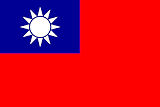
Kurz nach dem Umsturz muss Nationalchina seine Konsulate in den Provinzen schließen und seinen Botschafter in Bangkok durch einen Chargé d'affires ersetzen.
1949-10-15
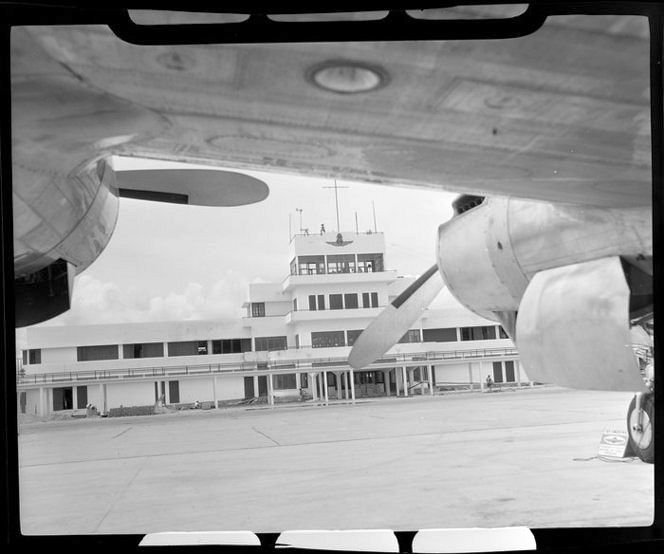
Abb.: Flughafen Don Muang. 1949-10-15
[Bildquelle:
View of control tower from under the wing of an aircraft, Bangkok airport,
Thailand. Whites Aviation Ltd :Photographs. Ref: WA-22501-F. Alexander Turnbull
Library, Wellington, New Zealand.
http://natlib.govt.nz/records/22495050. -- Zugriff am 2013-03-15. -- "You
can copy this item for personal use, share it, and post it on a blog or website.
It cannot be used commercially without permission"]
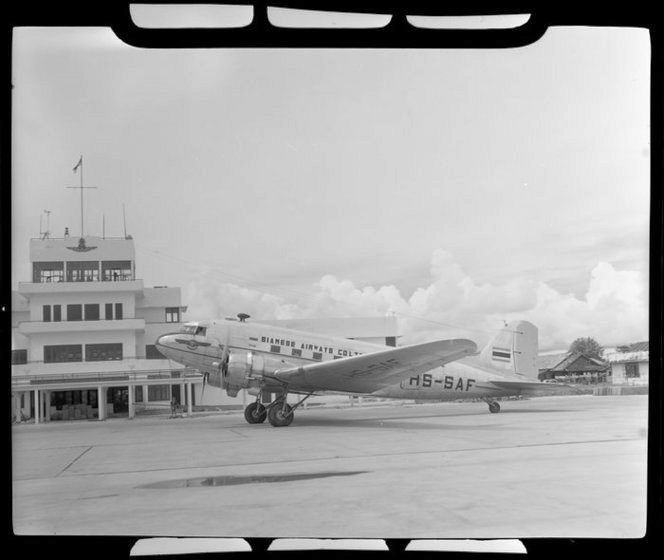
Abb.: Flugzeug der Siamese Airways, Bangkok,
1949-10-15
[Bildquelle: Siamese Airways aircraft HS-SAF at Bangkok
airport, Thailand. Whites Aviation Ltd :Photographs. Ref: WA-22500-F. Alexander
Turnbull Library, Wellington, New Zealand.
http://natlib.govt.nz/records/22788920. -- Zugriff am 2013-03-15. -- "You
can copy this item for personal use, share it, and post it on a blog or website.
It cannot be used commercially without permission"]

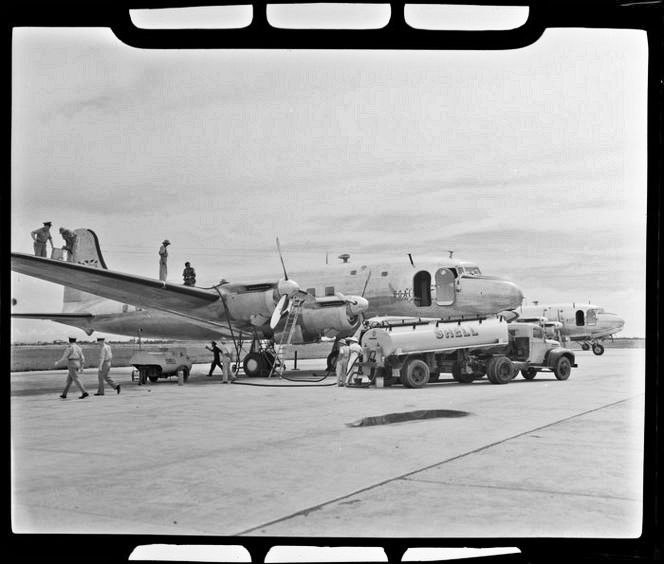
Abb.: BOAC (British Overseas Aircraft Corporation)
Flugzeug beim Auftanken in Bangkok, 1949-10-15
[Bildquelle: British
Overseas Airways Corporation aircraft being refueled from a Shell tanker,
Bangkok airport, Thailand. Whites Aviation Ltd :Photographs. Ref: WA-22499-F.
Alexander Turnbull Library, Wellington, New Zealand.
http://natlib.govt.nz/records/22590963. -- Zugriff am 2013-03-15. -- "You
can copy this item for personal use, share it, and post it on a blog or website.
It cannot be used commercially without permission"]
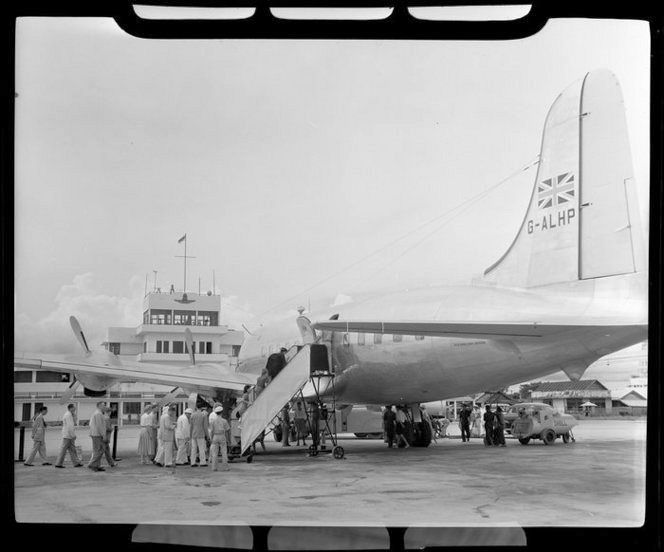
Abb.: Boarding eines Flugzeugs der BOAC (British
Overseas Aircraft Corporation), Bangkok, 1949-10-15
[Bildquelle:
Passengers boarding British Overseas Airways Corporation aircraft G-ALHP,
Bangkok airport, Thailand. Whites Aviation Ltd :Photographs. Ref: WA-22502-F.
Alexander Turnbull Library, Wellington, New Zealand.
http://natlib.govt.nz/records/22308996. -- Zugriff am 2013-03-15. -- "You
can copy this item for personal use, share it, and post it on a blog or website.
It cannot be used commercially without permission"]
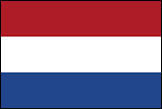
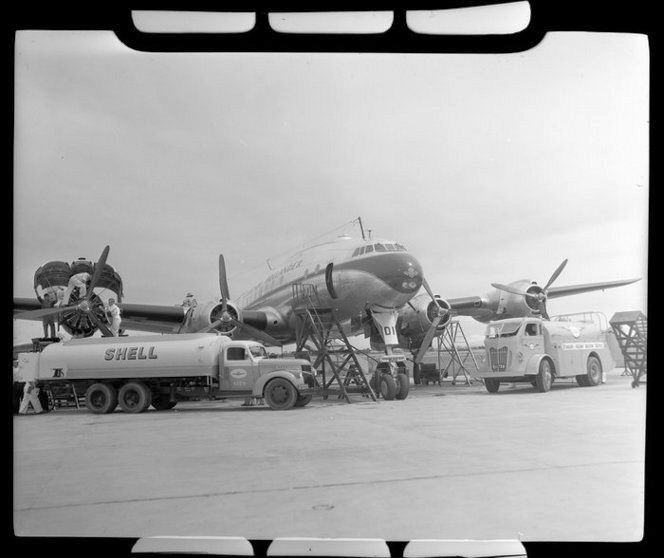
Abb.: KLM [Koninklijke Luchtvaart Maatschappij]
aircraft being refuelled from a Shell tanker, Bangkok, 1949-10-15
[Bildquelle: KLM aircraft being refuelled from a Shell tanker, Bangkok
airport, Thailand. Whites Aviation Ltd :Photographs. Ref: WA-22498-F. Alexander
Turnbull Library, Wellington, New Zealand.
http://natlib.govt.nz/records/22303366. -- Zugriff am 2013-03-15. -- "You
can copy this item for personal use, share it, and post it on a blog or website.
It cannot be used commercially without permission"]
1949-10-24

Die Lao-Issara-Exilregierung (ລາວອິດສະຫຼະ) in Bangkok löst sich auf. Ihre Mitglieder fliegen nach Vientiane (ວຽງຈັນ), wo sie einen triumphalen Empfang bekommen.
1949-10-31
Das Bangkoker Pasteur Institut - heute: Queen Saovabha Memorial Institute (QSMI) (สถานเสาวภา) - produziert das Tuberkuloseimpfmittel Bacillus Calmette Guérin (BCG). König Bhumibol unterstützt das Projekt mit 300.000 Baht aus seiner Privatkasse. Alle Einrichtungen werden von der WHO gestellt.
Abb.: Lage des Pasteur Instituts
[Bildquelle: OpenStreetMap. -- Creative Commons Lizenz (Namensnennung, share alike)]
Abb.: Lungentuberkulose, Röntgenbild
[Bildquelle: Wellcome Images. -- Creative Commons Lizenz (Namensnennung, keine kommerzielle Nutzung, keine Bearbeitung)]
1949-11-09

Frankreich gewährt Kambodscha beschränkte Souveränität innerhalb der Union Française.
Abb.: Kambodscha
[Bildquelle: CIA. -- Public domain]
Abb.: Union Française
[Bildquelle: Vadac / Wikipedia. -- Public domain]
1949-11-10

Tod von Ajahn Mun (Man) Bhuridatta Thera (มั่น ภูริทตฺโต / ຫຼວງປູ່ມັ່ນ ພູຣິທັຕໂຕ, 1870–1949)
Abb.: Ajahn Mun (Man) Bhuridatta Thera (มั่น ภูริทตฺโต / ຫຼວງປູ່ມັ່ນ ພູຣິທັຕໂຕ)
"Ajahn Mun Bhuridatta (Thai: หลวงปู่มั่น ภูริทัตโต, RTGS: Luang Pu Man Phurithatto, Aussprache: [lŭaŋ pùː mân pʰuːríʔtʰáttoː]; * 20. Januar 1870 in der Provinz Ubon Ratchathani (อุบลราชธานี), Thailand; † 10. November 1949 ebenda) war ein theravada-buddhistischer Mönch, der zusammen mit seinem Lehrer Ajahn Sao Kantasilo Mahathera (พระครูวิเวกพุทธกิจ / เสาร์ กนฺตสีโล, 1859 - 1941) als Gründer der thailändischen Waldtradition gilt, die sich in Thailand und später auch in westlichen Länder ausbreitete. [1] Leben Frühe Jahre als Novize und Mönch (1870–1901)
Ajahn Mun wurde am Donnerstag, dem 20. Januar 1870 in einem Bauerndorf namens Ban Kham Bong, im heutigen Amphoe Khong Chiam (โขงเจียม) der thailändischen Provinz Ubon Ratchathani, als ältestes von neun Kindern geboren. Ajahn Mun wurde mit 15 Jahren zum Novizen (Samanera / สามเณร) ordiniert, aber mit 17 (im Jahr 1888) wieder laisiert, um seinen Eltern zu helfen. Am 12. Juni 1893 erhielt er im Alter von 23 Jahren die Bhikkhu-Ordination. Dabei erhielt er den Ordinationsnamen Bhuridatta („Gesegnet mit Weisheit“).
Nach seiner Ordination lernte Ajahn Mun von 1893 bis ca. 1901 bei Ajahn Sao im Kloster Wat Liap in Ubon Dhamma, Vinaya und Meditation. Außerhalb der Regenzeitklausuren praktizierte er mit Ajahn Sao in abgelegenen Wäldern entlang des Mekong.
Alleine auf Dhutanga und Bangkok (1901–1911)Die Zeit zwischen etwa 1901 und 1911 verbrachte Ajahn Mun meist alleine auf Dhutanga-Wanderung (ธุตงฺค) in abgelegenen Gebieten Nordostthailands (Isan / อีสาน), Burmas und Laos. 1912 ging er nach Bangkok, wo er einige Regenzeiten im heutigen Wat Pathum Wanaram (วัดปทุมวนาราม) bei seinem Jugendfreund Than Cao Khun Upali (พระอุบาลีคุณูปมาจารย์ / จันทร์ สิริจนฺโท, 1857 - 1933), einem ranghohen Mönchsgelehrten und Meditator, verbrachte, um Pali und Suttas zu studieren.
Zentralthailand und Isan (1911–1929)Danach reiste Ajahn Mun nach Lop Buri (ลพบุรี) in Zentralthailand, um dort in verschiedenen Höhlen wie der Phaikwang-Höhle, der Singho-Höhle und in der Region des Berges Khao Phra Ngam intensiv zu meditieren. 1913 verbrachte er in der Sarika-Höhle im heutigen Nationalpark Khao Yai (อุทยานแห่งชาติเขาใหญ่), wo er einen wesentlichen Durchbruch seiner Praxis erzielte und der von seinem Schüler Ajahn Maha Bua (หลวงตา มหาบัว ญาณสัมปันโน, 1913 - 2011) geschriebenen Biographie zufolge die fünf niederen der zehn Daseinsfesseln (samyojana) abwarf und Nichtwiederkehrer (anāgāmi) wurde. Heute befindet sich bei der Höhle ein Kapellenschrein, der als Pilgerort besucht wird. Nach seiner Rückkehr nach Bangkok verfasste er sein schriftliches Hauptwerk, Khandhavimuttisamangīdhamma (ขันธะวิมุติสะมังคีธรรมะ) (etwa „Die Ballade von der Befreiung von den Khandhas“).[2]
In der Zeit zwischen 1915 und 1929 hielt sich Ajahn Mun wieder in Nordostthailand, entweder in improvisierten „Waldklöstern“ oder auf Wanderschaft auf. In dieser Zeit schlossen sich ihm 70 Mönche sowie Laienschüler an, um mit ihm zu praktizieren, darunter Ajahn Dun Atulo (พระราชวุฒาจารย์ / หลวงปู่ดูลย์ อตุโล, 1888 - 1985), ein bekannter Lehrer der thailändischen Waldtradition.
Nordthailand (1929–1940)1929 wurde Ajahn Mun zum Abt von Wat Chedi Luang (วัดเจดีย์หลวง) in Chiang Mai (เชียงใหม่) ernannt. Da er merkte, dass seine Lehrtätigkeit und sein Amt seiner weiteren Verwirklichung hinderlich war, verließ er das Kloster, um in Abgeschiedenheit praktizieren zu können und hielt sich wieder in abgelegenen Wäldern und in den Bergen auf. Nach Ajahn Maha Buas Biographie gelang es ihm in dieser Zeit, die fünf höheren Daseinsfesseln zu lösen und ein Arahat (อรหันต์) zu werden.
Zurück nach Isan (1940–1949)1940 kehrte Ajahn Mun im Alter von 70 Jahren auf Drängen seines Schülers Than Chao Khun Dhammacedi (พระธรรมเจดีย์ / จูม พนฺธุโล, 1888 - 1962), inzwischen Abt des Wat Photit Somphon in der Provinz Udon Thani, in den Isan zurück, wo er im Kloster Wat Boghisamphon (Provinz Udon Thani) lebte und die darauf folgende Regenzeit im Kloster Wat Non Niwet verbrachte. Danach besuchte er die Region um das Dorf Ban Nong Nam Khem, der Region in der er aufgewachsen war. Trotz seines hohen Alters war er in der Lage, für sich selbst zu sorgen und in der Wildnis zu leben. Ab 1944 lebte er 5 Jahre lang im Waldkloster bei Ban Nong Phue, die längste Zeit der Sesshaftigkeit seines Mönchslebens. 1946 teilte er seinen Schülern, darunter Ajahn Maha Bua und Ajahn La Khemapatto (พระอาจารย์หล้า เขมปตฺโต, 1911 - 1996) mit, dass er nur noch drei Jahre leben würde.
Im März 1949 erkrankte Ajahn Mun an einer Lungentuberkulose, daher ließ er sich nach der Regenklausurzeit in die Stadt Sakon Nakhon (สกลนคร) bringen, um das kleine Dorf Nong Phue nicht mit der Ausrichtung seiner Verbrennungsfeierlichkeiten zu überlasten. Dort wurde er in das Kloster Wat Suddhavasa (วัดป่าสุทธาวาส) gebracht, wo er am 10. November 1949 starb. Mehr als 1000 Mönche und Novizen und zehntausende Laienanhänger nahmen an der Kremationsfeier teil. Nach einigen Jahren wurden in den Knochenresten kristallene Reliquien (Sarira - พระบรมสารีริกธาตุ) gefunden.
Posthume WürdigungAjahn Mun wurde erst posthum zur Ikone des thailändischen Mönchstradition. Mit wenigen Ausnahmen war er Vertretern der arrivierten Hierarchie der Thammayut-nikai (ธรรมยุติกนิกาย) als „vagabundierender“ Waldmönch eher suspekt und erst ab Mitte der 1960er Jahre mit der Anerkennung von Meistern der thailändischen Waldtradition durch den thailändischen König wurde Ajahn Mun zum Aushängeschild. Im Wat Chedi Luang wurde ihm ein kleiner Wihan (วิหาร) mit einer Wachsfigur gewidmet.
WirkenMit seiner abgeschiedenen, entschlossenen und strengen Praxis war Ajahn Mun ein Vorbild für das monastische Leben, der sich strikt an die Vinaya hielt und alle 13 Dhutanga-Übungen befolgte, zum Beispiel das Essen ausschließlich aus der Almosenschale, Beschränkung auf eine Mahlzeit pro Tag und das Leben im Wald. Dadurch inspirierte er viele Mönche, die seine Schüler wurden. Ajahn Chah (พระโพธิญาณเถร / หลวงปู่ชา สุภทฺโท, 1918 - 1992) und Ajahn Maha Bua sind darunter die im Westen bekanntesten und in Thailand am höchsten verehrten. Als Gründer der thailändischen Waldtradition übte er wesentlichen Einfluss auf den Buddhismus in Thailand aus und durch Ajahn Chah, der viele Westler als Schüler hatte, auch auf die Verbreitung des Theravada-Buddhismus, die Gründung von Klöstern und die Etablierung des (Theravada-) Mönchs-Ordens im Westen."
[Quelle: https://de.wikipedia.org/wiki/Ajahn_Mun_Bhuridatta. -- Zugriff am 2016-12-19]
"Rebutting the sangha authorities’ prejudice against forest monks, the following comment of Man’s indicates that monks who followed modern state Buddhism were the ones who lost their inner bonds with local communities. Some people say that we live in the forest only to liberate ourselves spiritually. They say that even after we have gotten to "know" the dhamma [ธรรม], we choose to remain in the forest instead of coming out to help society. In fact, we have always served society by teaching these villagers. Villagers need both [kinds of monks]: those who know the dhamma superficially and those who understand the more subtle dhamma. We could not wait for the elite monks from sophisticated cities to come here and teach them. These scholars would not be willing to walk even a few kilometers. It is we who have really helped village folk."
[Quelle: Kamala Tiyavanich [กมลา ติยะวนิช] <1948 - >: Forest recollections : wandering monks in twentieth-century Thailand. -- Honolulu : Univ. of Hawai’i Pr., 1997. -- ISBN 0824817818. -- S. 224. -- Faire use]
Schüler von Ajahn Mun sind u.a.:
- หลวงปู่พรหม จิรปุญฺโญ (1888 - 1969)
- หลวงปู่ตื้อ อจลธมฺโม (1888 - 1974)
- หลวงปู่บัว สิริปุณฺโณ (1888 - 1975)
- Khao Analayo (หลวงปู่ขาว อนาลโย, 1888 - 1983)
- Waen Succinno (หลวงปู่แหวน สุจิณฺโณ, 1888 - 1985)
- Dun Atulo (พระราชวุฒาจารย์ / หลวงปู่ดูลย์ อตุโล, 1888 - 1985)
- พระธรรมเจดีย์ / จูม พนฺธุโล) (1888 - 1997)
- หลวงปู่บุดดา ถาวโร (1894 - 1994)
- สมเด็จพระมหาวีรวงศ์ / พิมพ์ ธมฺมธโร (1897 - 1974)
- Fan Ajaro (หลวงปู่ฝั้น อาจาโร, 1898 - 1977)
- หลวงปู่กงมา จิรปุญฺโญ (1900 - 1962)
- หลวงปู่หลุย จนฺทสาโร (1901 - 1989)
- Chob Thanasamo (หลวงปู่ชอบ ฐานสโม, 1901 - 1995)
- หลวงปู่อ่อน ญาณสิริ (1902 - )
- หลวงพ่อผาง จิตฺตคุตฺโต (1902 - 1985)
- Thet Tetrangsi (พระราชนิโรธรังสี คัมภีรปัญญาวิศิษฎ์ / หลวงปู่เทสก์ เทสรงฺสี,1902 - 1994)
- Li Dhammadharo (พระสุทธิธรรมรังสีคัมภีรเมธาจารย์ / ท่านพ่อลี ธมฺมธโร, 1907 - 1961)
- พระญาณสิทธาจารย์ / หลวงปู่สิม พุทฺธาจาโร (1909 - 1992)
- พระมงคลวุฒ / หลวงปู่เครื่อง สุภทฺโท (1910 - 2008)
- La Khemapatto (พระอาจารย์หล้า เขมปตฺโต, 1911 - 1996)
- พระอุดมญาณโมลี / จันทร์ศรี จนฺททีโป (1911 - 2016)
- หลวงปู่ผินะ ปิยธโร (1913 - 2002)
- พระอริยเวที / พระอาจารย์มหาเขียน ฐิตสีโล (1913 - 2004)
- Ajahn Maha Bua (พระธรรมวิสุทธิมงคล / หลวงตามหาบัว ญาณสมฺปนฺโน) (1913 - 2011)
- พระครูสุทธิธรรมรังษี / หลวงปู่เจี๊ยะ จุนฺโท (1916 - 2004)
- พระเทพวิสุทธิมงคล / หลวงปู่ศรี มหาวีโร (1917 - 2011)
- สมเด็จพระมหาวีรวงศ์ / มานิต ถาวโร (1917 - )
- Chah Subbhado (พระโพธิญาณเถร / หลวงปู่ชา สุภทฺโท, 1918 - 1992)
- Juan Kulachettho (หลวงปู่จวน กุลเชฏฺโฐ, 1920 - 1980)
- พระธรรมมงคลญาณ / หลวงพ่อวิริยังค์ สิรินฺธโร (1920 - )
- Wan Uttamo (พระอุดมสังวรวิสุทธิเถร / หลวงปู่วัน อุตฺตโม, 1922 - 1980)
- พระวิสุทธิญาณเถระ / หลวงปู่สมชาย ฐิตวิริโย (1925 - )
1949-11-15
Indochinaflüchtlinge werden nur noch unter einer strengen Quotenregelung ins Land gelassen.
1949-11-15
Feierliche Wiedereröffnung der wieder aufgebauten Memorial Bridge (สะพานปฐมบรมราชานุสรณ์) in Bangkok. Die Brücke war am 1944-06-05 während eines Luftangriffs durch B-29 Superfortresses schwer beschädigt worden.
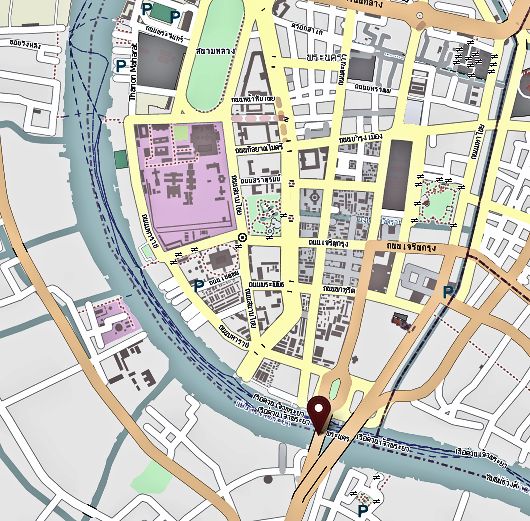
Abb.: Lage
der Memorial Bridge (สะพานปฐมบรมราชานุสรณ์)
[Bildquelle: OpenStreetMap. --
Creative Commons Lizenz (Namensnennung, share alike)]
1949-11-30

Die "Bank of America" (ธนาคาร แห่งอเมริกา) eröffnet ihre Niederlassung in Bangkok. Es ist dies die erste Zweigstelle einer US-Bank.
1949-12-03 - 1949-12-11

Meeting of the International Missionary Council and the World Council of Churches in Bangkok. Man beschließt die Voraussetzungen für die 1959 gegründete East Asia Christian Conference (EACC).
1949-12-07
Gründung der International Confederation of Free Trade Unions (ICFTU).
Abb.: ®Logo
[Bildquelle: Wikimedia. -- Fair use]In Thailand gehört der ICFTU an der Phibun-nahestehende สมาคมกรรมกรไทย (Thai National Trade Union Congress). Diese und andere antikommunistische Gewerkschaften stehen unter der Kontrolle von Phibuns Vertrautem Sang Phatnothai (สังข์พัธโนทัย).
"The International Confederation of Free Trade Unions (ICFTU) was an international trade union. It came into being on 7 December 1949 following a split within the World Federation of Trade Unions (WFTU), and was dissolved on 31 October 2006 when it merged with the World Confederation of Labour (WCL) to form the International Trade Union Confederation (ITUC). Prior to being dissolved, the ICFTU had a membership of 157 million members in 225 affiliated organisations in 148 countries and territories.
In 1949, early in the Cold War, alleging Communist domination of the WFTU's central institutions, a large number of non-communist national trade union federations (including the U.S. AFL-CIO, the British TUC, the French FO, the Italian CISL and the Spanish UGT) seceded and created the rival ICFTU at a conference in London attended by representatives of nearly 48 million members in 53 countries.
From the 1950s the ICFTU actively recruited new members from the developing regions of first Asia and subsequently Africa. Following the collapse of Communist party government in the Soviet Union and eastern Europe, the Federation's membership has risen steeply from 87 million in 1988 and 100 million in 1992, as trade union federations from former Soviet bloc countries joined the ICFTU.
The ICFTU was formally dissolved on 31 October 2006 when it merged with the World Confederation of Labour (WCL) to form the International Trade Union Confederation (ITUC)."
[Quelle: http://en.wikipedia.org/wiki/International_Confederation_of_Free_Trade_Unions. -- Zugriff am 2015-02-11]
1949-12-08

Die Regierung Nationalchinas muss nach ihrer Niederlage gegen die Kommunisten ihren Sitz von Chengdu (成都市, Sizhuan - 四川省) nach Taipeh (臺北市) auf Taiwan ( 臺灣, Formosa) verlegen.
Abb.: Lage von Taipeh (臺北市)
[Bildquelle: OpenStreetMap. -- Creative Commons Lizenz (Namensnennung, share alike)]
1949-12-10

Kunming (昆明) fällt an Rotchina. 1950-02-25 wird offiziell die Eroberung Yunnans (雲南) durch die Volksbefreiungsarmee (中國人民解放軍) gefeiert.
Abb.: Lage von Kunming (昆明)
[Bildquelle: OpenStreetMap. -- Creative Commons Lizenz (Namensnennung, share alike)]

Nationalchina hät noch Mengzi (蒙自市)
Abb.: Lage von Mengzi (蒙自市)
[Bildquelle: OpenStreetMap. -- Creative Commons Lizenz (Namensnennung, share alike)]
1949-12-10
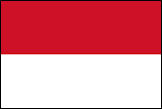
Amsterdam: Juliana Louise Emma Marie Wilhelmina van Oranje-Nassau (1909 - 1980), Königin der Niederlande, unterschreibt die Entlassungsurkunde Indonesiens (Nederlands Indië) in die Unabhängigkeit. Damit sind fast 350 Jahre Fremdherrschaft beendet.
Abb.: Nederlands Indië 1949
[Bildquelle: Clockwork Orange / Wikipedia. -- GNU FDLicense]
1949-12-14

Eröffnung der Thai Botschaft in Rangoon (ရန်ကုန်) (Burma). Die Zeremonie wird von thailändischen und birmanischen Mönchen geleitet.
Abb.: Lage von Rangoon (ရန်ကုန်)
[Bildquelle: Wellcome Images. -- Creative Commons Lizenz (Namensnennung, keine kommerzielle Nutzung, keine Bearbeitung)]
1949-12-20

Das US State Departement beginnt, in Thailand, Südkorea, Vietnam und Indonesien eine Serie von Comics über amerikanische Nationalhelden zu verteilen. Die 32 Seiten starken Comics in den jeweiligen einheimischen Sprachen behandeln Leben und Werk von George Washington, Thomas Jefferson, Walt Whitman, Thomas Edison und George Washington Carver.
Abb.: Mit US-Comics beglückte Länder
[Bildquelle: CIA. -- Public domain]
1949-12-22

Erstflug des North American F-86D Sabre. Thailand wird 20 Stück F86L beziehen.
Abb.: North American F-86D Sabre der Royal Thai Airforce, 1966
[Bildquelle: USAF / Wikimedia. -- Public domain]
1949-12-23
Es erscheint:
Arnold, James Richard <1923 – 2012> , W. F. Libby, Willard Frank <1908 – 1980>: Age Determinations by Radiocarbon Content, Checks with Samples of Known Age. -- In: Science <Washington DC> 110.1949,12 (23. Dez.)
Diese Arbeit ist der Beginn der Radiokarbonmethode (Radiokohlenstoffdatierung / 14C-Datierung / Radiocarbondatierung), die eine ziemlich genaue Datierung von Objekten im Zeitraum von 300 und etwa 60.000 Jahren ermöglicht. In Thailand werden damit vor allem archäologische Objekte datiert werden
1949-12-27


Die Königin der Niederlande, Juliana Louise Emma Marie Wilhelmina (1909 - 2004) unterzeichnet in Amsterdam die Souveränitätsübergabe Indonesiens. Damit wird die bisherige niederländische Kolonie ein unabhängiger Staat.
Abb.: Unterzeichnung der Souveränitätsübergabe Indonesiens, 1949-12-27
[Bildquelle: Wikipedia. -- Public domain]
Abb.: "Republik Indonesia Serikat - Vereinigte Staaten von Indonesien", 1949-12 (rot: Republik Indonesien)
[Bildquelle: Davidelit / Wikipedia. -- GNU FDLicense]
"Im Frühjahr 1942 begann die japanische Armee Niederländisch-Indien zu besetzen. Ihr Interesse galt kriegswichtigen Rohstoffreserven und der Verbesserung ihrer strategischen Position. Im März 1942 kapitulierten die Niederländer. Die fast 350-jährige Zeit ihrer Kolonialherrschaft war vorüber. Noch unter japanischer Besatzung erklärt sich Indonesien im März 1943 von den Niederlanden unabhängig. Die Herrschaft der Japaner endete am 15. August 1945 mit deren Kapitulation. Am 17. August 1945 riefen Sukarno (1901 - 1970) und Mohammad Hatta (1902 - 1980) die Unabhängigkeit Indonesiens aus. Der Einfluss der Republik Indonesien erstreckte sich zunächst auf die Inseln Java, Sumatra und Madura. Die übrigen Inseln wurden meist von den Niederländern kontrolliert. Im Niederländisch-Indonesischen Krieg (1947/48) eroberten die Niederlande zwar fast das gesamte Gebiet, kämpften aber weiterhin gegen eine indonesische Guerilla und verloren vor allem die Sympathie der Weltöffentlichkeit, nicht zuletzt wegen des Massakers am 9. Dezember 1947 in dem Dorf Rawagede (West-Java) mit 431 Toten, bei dem nur zehn Männer überlebten. Unter amerikanischem Druck mussten die Niederlande im August 1949 (abermals) Verhandlungen mit der Republik Indonesien aufnehmen. Am 27. Dezember 1949 wurde in Amsterdam die Übergabe der Souveränität unterzeichnet, der niederländische Teil von Neuguinea West-Papua blieb jedoch vorläufig unter niederländischer Verwaltung."
[Quelle: http://de.wikipedia.org/wiki/Republik_Indonesien#Geschichte. -- Zugriff am 2012-06-25]
ausführlich: http://www.payer.de/thailandchronik/ressourcen.htm
Zu Chronik 1950